IT'S TIME TO UPGRADE YOUR LIVING ROOM LIGHTS!
Tired of not being able to see what you're doing? Old out-dated light fixtures which look ancient or plain ugly? You've got some lighting but it's still not bright enough to read a book? Or your rooms just don't have enough lighting fixtures built-in?
You shouldn't have to suffer in the dark!
It's time to shed light on your situation with these powerful living room design tips.
Read on forexpert living room decorating ideas to help you bring your living room design ideas to life!
Ask yourself, what do you want your living room lighting to do?
When deciding how to decorate a living room with better lighting, there are different types of living room light fixtures and lamps designed for different purposes.
Throwing in some living room lighting fixtures might not be the best idea if you need bright light next to a chair. Or a couple of living room lamps may not be enough ambient light to fill a family room for your next Super Bowl party. You might even just have the wrong type of lamp shades attached for your needs.
Think about what each area of the living room needs
Try breaking down the room into functional areas.
Ask yourself, where do you need the most light?
Does it need to be bright and focused or a background ambient light?
- Lighting the whole living room in general raises overall ambient light
- A brighter light near to where you perform activities helps you read and focus
- Adding decorative accent lamps highlights your living room decor and furniture
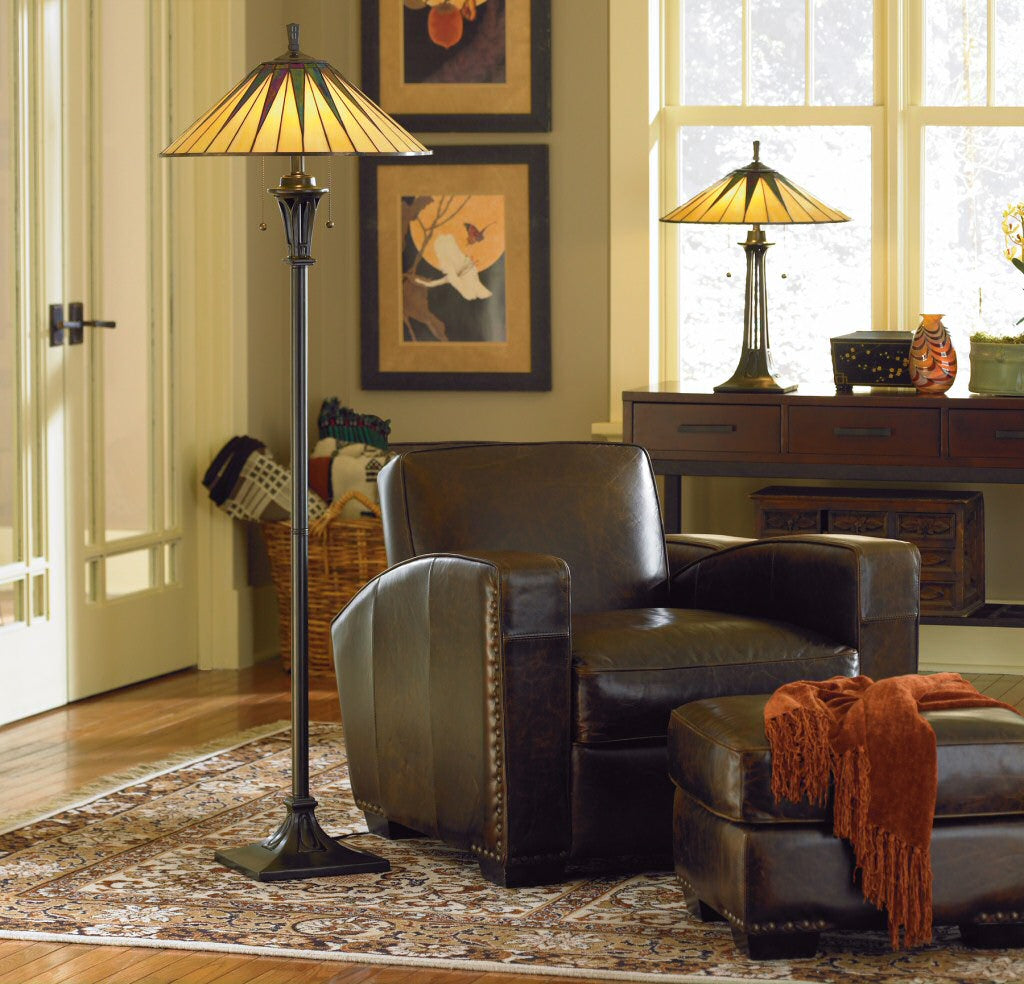
Match the most appropriate type of lighting to the kind of light you need
Modern living room lighting design can feature either ambient lighting, task lighting or accent lighting.
These different kinds of light placement and "concentration" are mainly to do with how focused or localized the light is - is it spread out (diffused) through the room reflecting off surfaces, or is there more direct focused light close to a person performing an activity.
Did you know there are different forms of lighting?
Different types of light fixtures and lamps attempt to solve one problem:. "How do I position light at the correct horizontal and vertical position in a room to serve a purpose?"
This is usually accomplished through different forms or shapes of light. The physical design of the fixture or lamp itself makes use of one of three possibilities:
- 1. Ceiling lights, for example hanging from a chain making use of gravity, or attached close to the ceiling itself
- 2. Floor lights, attempting to overcome gravity, for example with a floor-standing lamp or an accent up-light
- 3. Table lights, placing light in the mid-level of the room by sitting the light source on top of embedded into some other furniture, such as with a table lamp, desk lamp, or low hanging pendant light
Different types of lights
Types of lights may spread the light out in different ways depending on the design. For example a table lamp typically reflects some light out the top and bottom of the shade spreading it out more below, whereas a chandelier may radiate light in all directions.
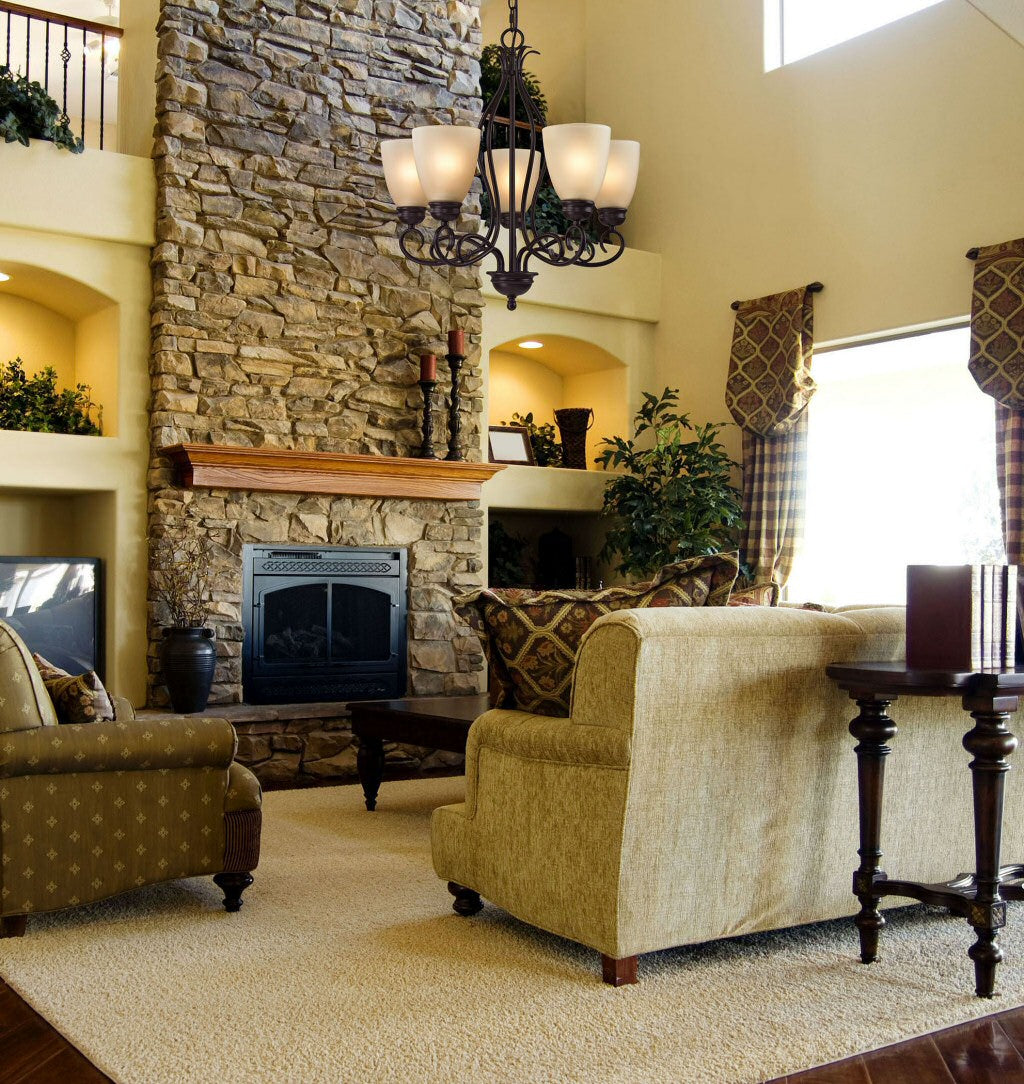
We'll begin with a brief overview of each of the main types of lighting and their intended use.
What is Ambient Lighting?
Ambient light is general diffused background light which fills the room and raises the overall light throughout the room. Ambient light fills the room but may not be sufficient for specific activities like reading in a chair. Most ambient light is usually provided by living room lighting fixtures.
Types of light fixtures producing ambient light for your living room include:
- Chandeliers hanging from the ceiling
- Pendant lights hanging from the ceiling
- Wall sconces at the sides of the room
- Flush or close-to-ceiling light fixtures over-head
- Recessed lights across the ceiling
- A living room ceiling fan with a "light kit" attached

What is Task Lighting?
Task lights shine bright light on specific tasks and allow you to highlight a more specific area - next to a chair, over a table, in a cozy corner, etc. These living room lamp ideas help you to perform tasks where you need brighter light to see.
Types of lights for more specific living room activities include:
- Table lamps next to a chair or sofa or in the corners of the room
- Reading lamps next to a chair or couch
- Desk lamps on a desk where you might handle paperwork
- Task lamps designed for hobbies and crafts
- Full spectrum lamps which are excellent next to a chair for reading or crafts
- Some smaller pendants and swag lights positioned over a seating area
- Swing-arm lamps and wall lights which can extend out close to a chair or table
- Piano lamps or banker's lamps which provide focused downward light over a piano or keyboard
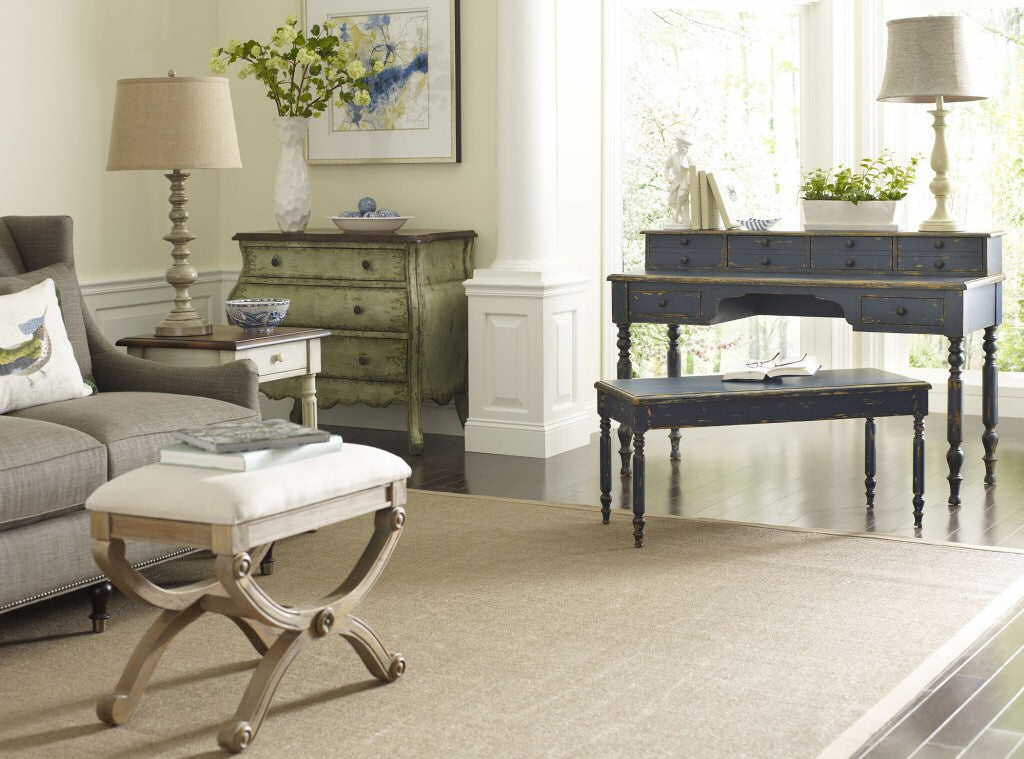
What is Accent Lighting?
Accent lights are more for decoration and add subtle touches to a living room's lighting. They show off certain features in the room and add a soft local glow in specific areas.
Types of lighting for accenting your living room decor include:
- Accent lamps, novelty lamps and decorative tiffany lamps
- Up-lights or can lights positioned near the floor shining upwards
- Spot lights and picture lights for highlighting artwork and other living room decorations

Finer details to pay attention to when choosing lighting
Some things may seem more obvious. Just putting "a light" somewhere in the room will certainly help. But sometimes you may not get the results you expected.
Here are some living room lighting tips to keep in mind:
- The number of light bulbs and the amount of light they output (measured in watts or, more accurately, lumens)
- The distance from the light bulb to significant objects, surfaces or people (influences how much light reaches the subject)
- The lightness or reflectivity of objects and surfaces (darker surfaces absorb light, lighter walls make better use of your light fixtures)
- The type of light bulbs and the color temperature (lower Kelvin "temperature" are more yellow, higher are more white or blue)
- How shielded the light bulbs are by a shade or cover - these will either block or diffuse the light
- The "shape" of the light output by the light fixture or lamp, ie what kind of directions the light radiates - is it upwards, downwards, sideways, all directions? This is in large part dictated by the style of lamp shades used.
- The amount of sunlight entering the room - can you remove furniture or other items which block the natural daylight, and is there enough lighting at night when there is no sunlight?
- What kind of reflections, lit areas or shadows the light might produce, for example on walls and ceilings, and can you use this as a deliberate interior design feature?
- The coloration of the shade covering the light bulb - this will influence and filter the light output, "coloring" the whole room with a tint. For a full range of color representation you'll want some white or full spectrum lights that are "unfiltered" by the light shade itself.
- Beware of light fixtures with not enough wattage or brightness. Some decorative fixtures might be designed more for looks (e.g. use of low-wattage decorative vintage bulbs) rather than to significantly light the room, unless that's what you want
Living room lighting fixtures bring outstanding benefits to your living room or family room
Your modern living room lighting will be well served by adding appropriate lighting fixtures or lamps. Each type of light brings with it tremendous benefits for the whole family.
The many benefits of ambient lighting in your living room

- Background lighting is especially useful when the weather is darker or at night and light from other lamps is just not enough
- Ambient lights instantly illuminate the whole living room and can be switched off when you want gentler light from individual lamps
- Ambient light fixtures can be attached to a dimmer switch to make them dimmable and set the mood - even LED light fixtures are now dimmable
- When you first enter a room and need to get your bearings, switching on a bright room light is the best choice without having to enter the room further to access a lamp switch
- For those times when you are doing something out of the ordinary - cleaning or hunting for the TV remote, living room light fixtures can be very useful for highlighting every area at once
- With multiple people in a room together for a family reunion or time to eat casual dinner in front of the TV, lights for living room ceilings may be the best option
See some Ceiling Lights or Look at some wall lights
Highly practical benefits of adding task lights and lamps
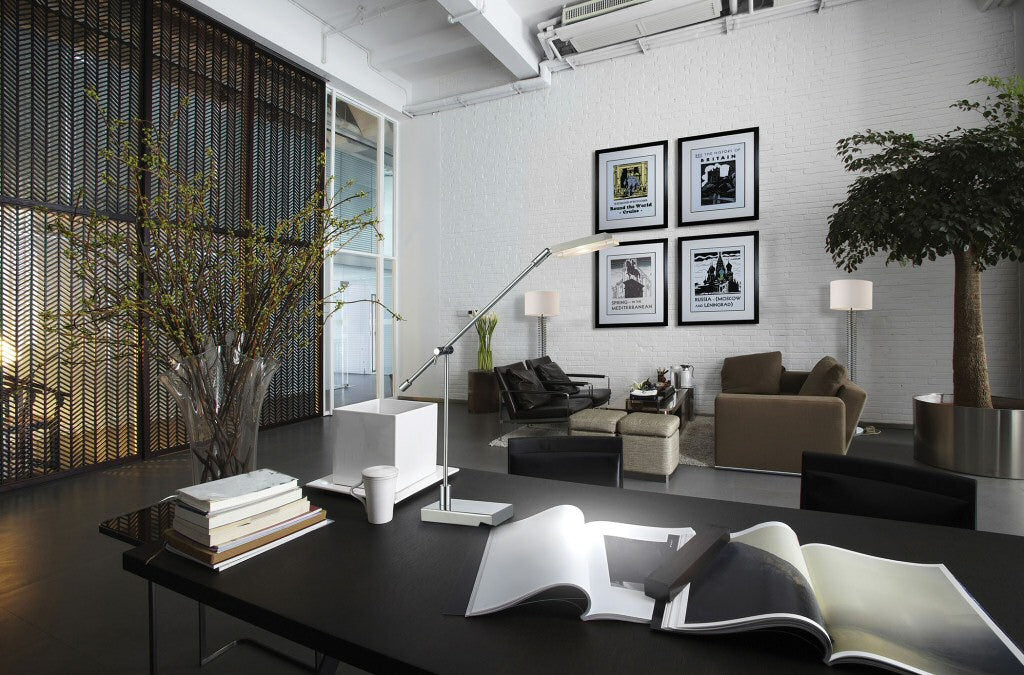
- You are not always using the whole room, so why light areas of the room that aren't serving your current functions?
- General ambient light may not be bright enough for specific tasks such as reading a book in your favorite chair, reducing glare while you connect with your friends on your mobile device, or for crafts and hobbies
- The closer you are to the source of the light the brighter the light will appear to be
- You'll spend most of your time sitting in specific areas of the living room rather than moving about. Whether browsing a photo album with visiting relatives or lounging in front of the best shows on TV, you'll want the light to be where YOU are
- Most task lamps are portable forms of lighting - they can easily be moved or manipulated to adjust the direction and focus and brightness of the light
- Table lamps and floor lamps are excellent ways to put the light exactly where you need it when you're settling in to spend some time focusing on living room activities
- When you just want a lower level of light, switching on some lamps may suffice to set the mood and create a relaxed atmosphere
See examples of Living room Lamps
Wow everyone with accent lights as finishing touches
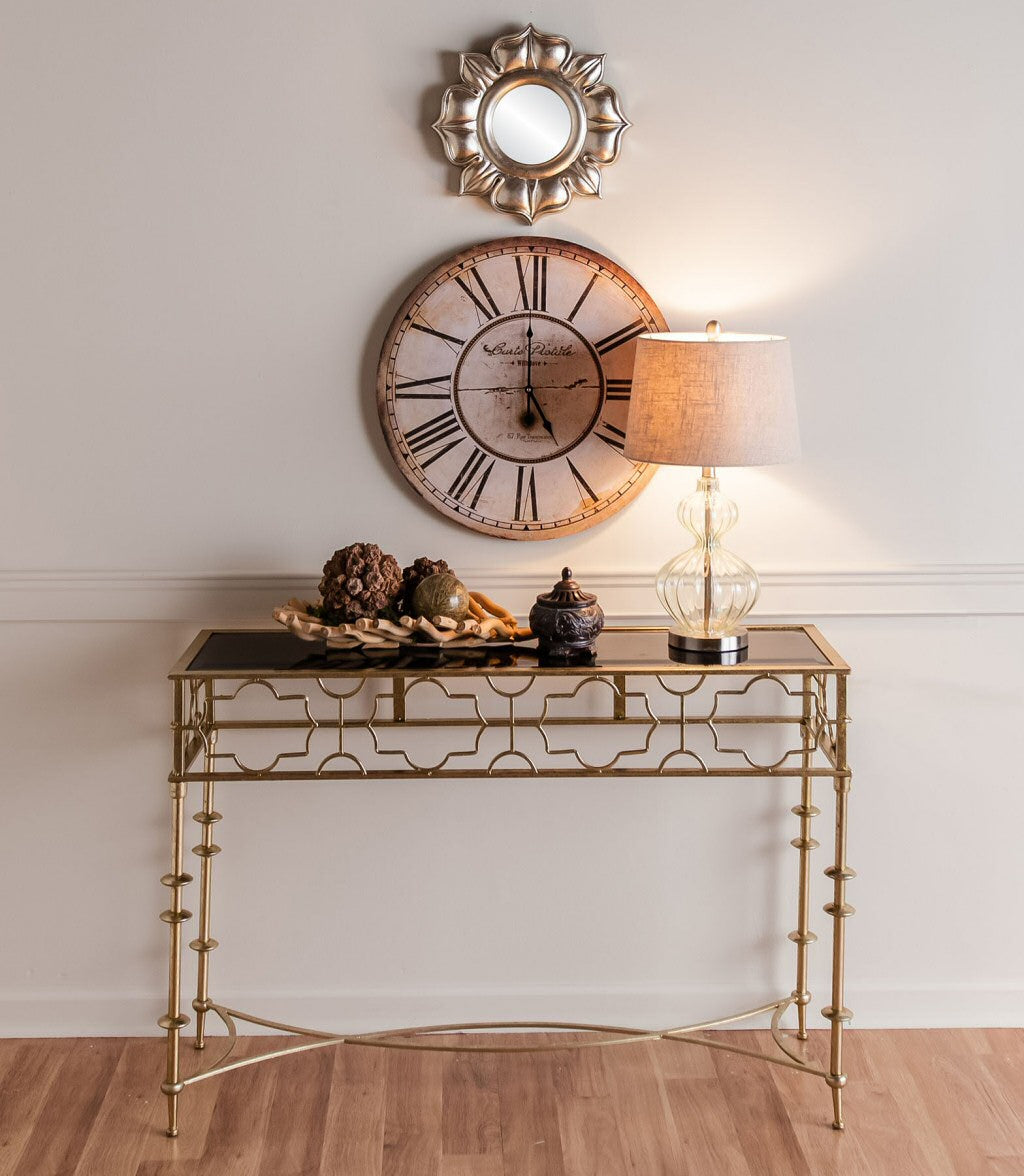
- It's not always about functional lighting. A living room space is also a place of comfort, featuring collections of your favorite decor and works of art
- Sometimes specific lamps or overhead lights may not reach certain parts of the room especially at the walls. A mantel, fireplace or side table might need a little accent lamp to help highlight the area
- Accent lamps are highly decorative art pieces in themselves, so serve a double purpose of decorating the room and establishing your living room themes, as well as providing an extra touch of light in the room
- Tiffany lamps make excellent gifts as well as beautiful ways to use your lighting in a decorative way, shining light through colored pieces of glass designed to attract the eye and finish the room
- Small lights in small areas like up-lights or can lights can shine lights onto walls and surfaces to break up large areas of monotonous color or to soften the look of hard surfaces
- Subtler touches in your living room decor adds to the overall atmosphere and mood of the room - beauty is often in the little details
Take a look at some Accent Lamps
Living room design ideas to create beautiful and functional living rooms
Every living room should feature a combination of at least ambient lighting and focused task lighting. Accent lighting is an optional extra touch.
Lighting essentials
- At least one or more light fixture, preferably a living room ceiling light which can spread light throughout the room
- At least 1 or more lamp - living room floor lamps are popular for spreading brighter light in a more diffused way, while living room table lamps are popular for bringing the light closer to your eyes
A living room lighting apartment solution
If you live in an apartment or some room where you cannot install light fixtures, or you don't want to make a permanent modification, a combination of swag pendant lights or plug-in wall lights and some portable lamps will work wonders. This is also a great way to save money by avoiding the need for an electrician.
Read on for cool living room lighting ideas from our lighting experts.
Average-sized living room design ideas

The living room layouts below are designed for a typical-sized living room with 3-4 people occupancy, large enough to install a couch, a TV, maybe an armchair and some other small furniture. Cool lighting ideas for living rooms include:
Option 1: An central light fixture, two wall lights and a pair of table lamps
Ambient lighting: (A) Centralized light fixture and (B) wall lights.
Task lighting: (C) Table lamps.
Ideal for: those who can install light fixtures and are making use of opposite walls.
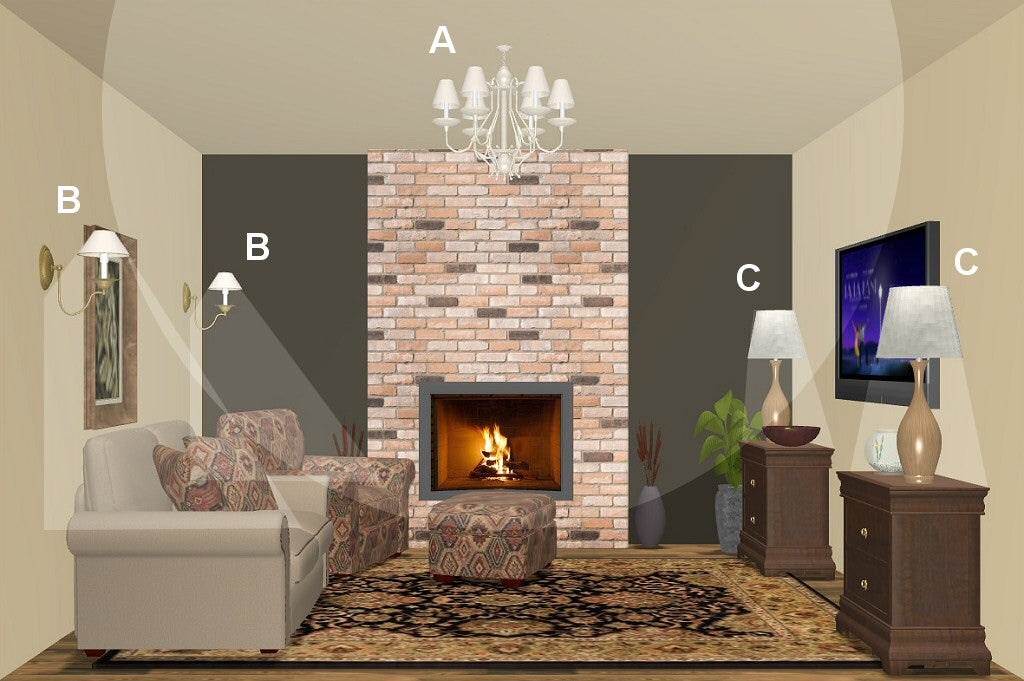
This arrangement places a decorative light fixture in the center of the room which will illuminate most of the room, and then accents it with short-range lights nearer the edges of the room.
If you have high ceilings you may have room for a living room chandelier or pendant. These will hang down so you'll need several feet of additional height to walk beneath them. But they can add beautiful thematic lighting to your room.
If you don't have the head-room, opt for a semi-flush close-to-ceiling light. These have a more decorative design and are not as boring or ugly as basic dome lights.
A pair of wall lights on a major wall, such as behind a couch, can offer additional brightness when you need it. Seating is usually placed away from the center of the room so it helps to bring extra light close to where you'll spend time.
Wall lights can also illuminate over your shoulder for reading. Alternatively place them opposite the couch, typically behind the television.
Complete the balance of light by arranging a pair of table lamps, either at the sides of the couch on end tables, or in the opposite corners of the room. The lamp shades will shield your eyes while remaining in your field of vision.
Placing lamps on the same side as the TV gives you the option of lighting that area or switching the lamps off while you watch the screen. It can sometimes help reduce glare from the TV by having other lights nearby.
And consider this...
If you put your main lounge room light fixture on a separate switch or circuit, you now have the option of 3 different levels of light, including a nice cozy room using just the wall lights and table lamps.
Ceiling Light Examples Wall Light Examples Table Lamp Examples
Option 2: A pair of pendant lights, a torchiere floor lamp and a table lamp
Ambient lighting: (B) Floor and (C) table lamps.
Task lighting: (A) Pendant lights over seating areas.
Ideal for: You can install light fixtures and also would like a secondary and/or portable level of light.
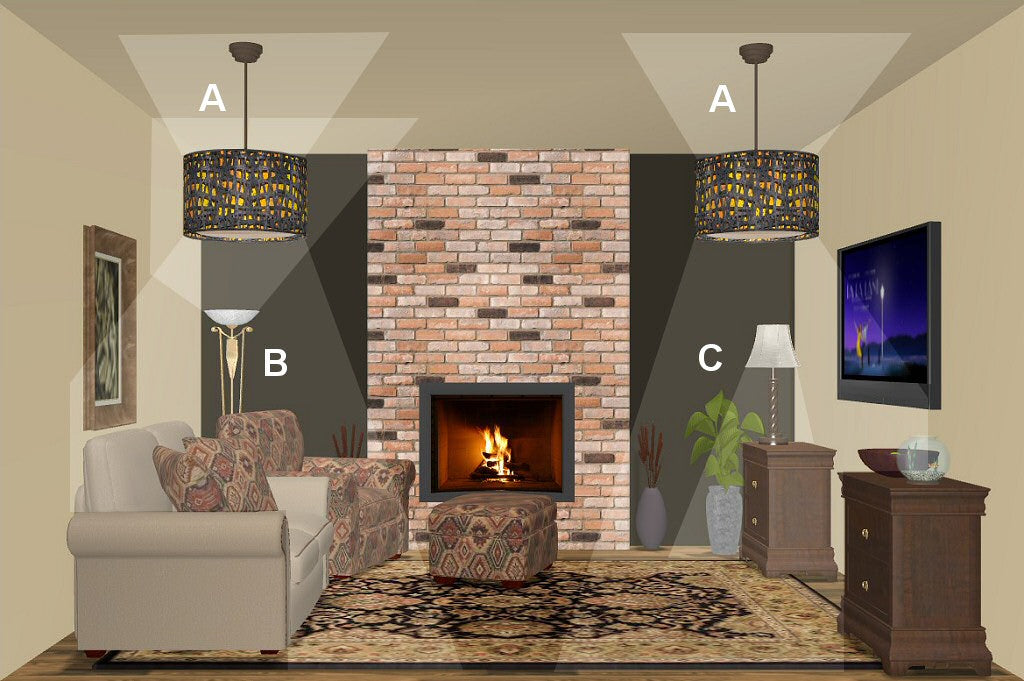
Pendant lights can hang over an area of the living room where you may not be standing, such as over a couch or chair, over a table or some other furniture.
Since they provide a more focused downward light in a specific area, pendants can be used almost like task lights to highlight parts of the room.
To complement the downward-focused light, place a torchiere-style floor lamp in the corner of the room. Floor lamps tend to be a higher wattage or lumens than table lamps and can give a boost to the ambient light.
A torchiere or torch standing lamp aims light upward and so reflects off the ceiling, complementing the pendant lights in building the overall light level. Some torchieres also feature a reading arm which can make them useful next to a chair.
Finish the look with a mid-level light from a table lamp. Placed in a corner or next to a significant seating area it can help you to see for specific tasks and also draw attention to a more active part of the room.
Do you want to enjoy a comfortable evening in?
Then switch off the pendants and just use the floor lamp and table lamp for a soothing experience.
Examples of Pendants Examples of Floor Lamps Examples of Table Lamps
Option 3: A hanging swag light, a pair of floor lamps and a desk lamp
Ambient lighting: (B) Floor lamps.
Task lighting: (A) Plug in swag pendant and (C) desk lamp.
Ideal for: You cannot install light fixtures but want overhead light as well as occasional task lighting.
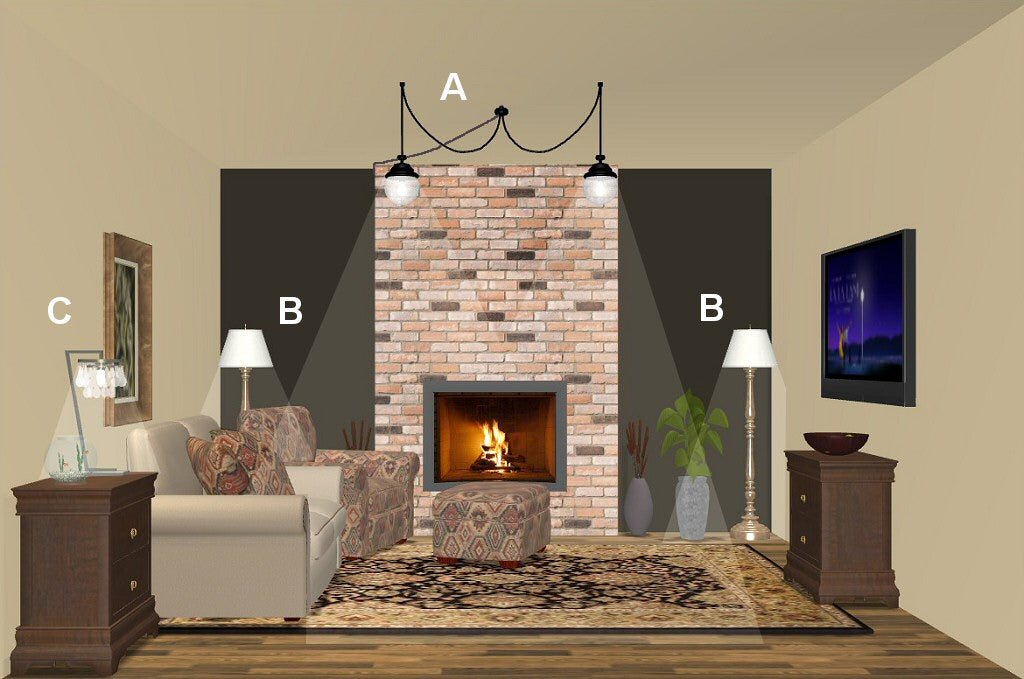
If you can't install any light fixtures or hard-wired lighting, the next best option is portable lamps or lighting which can be plugged into a regular wall socket.
A plug in pendant light or swag light features a chain or cord which "swags" or drapes across the ceiling from some hooks, and then down the wall to a regular plug socket.
It's easy to install, requires no electrical experience and can easily be moved to another part of the room or another room entirely. Plus it comes with you if you move house.
As a pendant, the swag light can be positioned over a significant area such as a chair or table, or nearer the center of the room if your ceiling is high enough.
Remember that since the vertical position of the swag pendant is adjustable you can place it much closer to the ceiling if you don't have as much room. It can then serve to provide ambient ceiling light to the whole room or to focus on a specific area.
Floor lamps are your next best friends. They tend to be a higher wattage or brighter light output. They either can aim light upward toward the ceiling, out sideways, downwards or in all directions depending mostly on the shade design.
Place the floor lamps in two complementary corners of the living room, or alongside the couch. These tall standing lamps raise the light bulbs higher in the room above eye-level when seated and are particularly out of sight if behind you while seated on the couch.
Finally to give you a focused light for those occasions when you really need to see some details, choose an adjustable desk lamp.
The desk lamp can sit on a side table or desk near to where you spend the most time, and with an adjustable arm you can move it quickly to focus the light exactly where you need it.
With 3 lamps and a pendant light, each with their own switch, you'll have a number of different levels of illumination to choose from.
Examples of Swag Lights Examples of Floor Lamps Examples of Desk Lamps
Option 4: A ceiling fan with a light kit, a reading lamp and a table lamp
Ambient lighting: (A) Ceiling fan with a built-in light, and (C) table lamp.
Task lighting: (B) Reading lamp.
Ideal for: You want an all-in-one installed light fixture complemented with a table lamp, then a reading lamp for specialized activities.
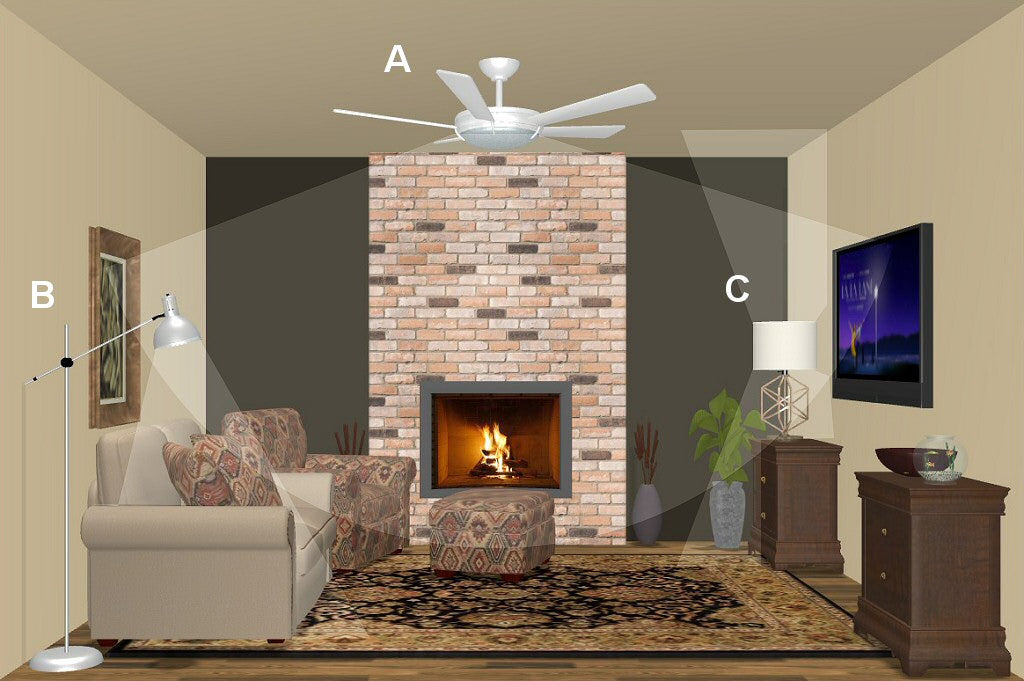
In a comfortable living room sometimes you need a ceiling fan not only to cool the room in summer but also to help the heat to circulate in winter.
Many ceiling fans come equipped with (or can have added) a light kit, which is a small light fixture typically suspended under the fan. Some fans also have upward-facing lights which add soft ambient light reflected off the ceiling, as a more decorative feature.
You'll be able to operate the fan itself separately from the light fixture. The light kit can contain anywhere from 1 to 4 bulbs. A fan is usually centrally located in the room to provide a general ambient light for the room, or a brighter light if positioned above a seating area.
To complement the fan, add a reading floor lamp. Reading lamps feature an adjustable arm which extends outward and shines light downwards. It can be positioned next to or behind a chair or couch to give you a focused bright light in a small area.
Be sure to check out full spectrum reading lamps which are designed to provide natural light which makes reading and other tasks much easier on the eyes, rendering colors more accurately and reducing glare.
Complete the lighting with an extra table lamp. Since your reading lamp may serve most purposes near to your favorite chair, the table lamp can sit in an opposite or complementary corner to balance the overall light and make sure you don't have dark corners in the room.
Let your fan keep you at the perfect temperature while your lamps soothe your mood.
Examples of Ceiling Fans Examples of Reading Lamps Examples of Table Lamps
Option 5: A close-to-ceiling light fixture, two canister up-lights, a pair of wall lights and one or two accent lamps
Ambient lighting: (A) Living room ceiling lights, (B) can lights, (C) wall lights and (D) accent lamps.
Task lighting: None - uses the overall ambiance.
Ideal for: You can install some ceiling light fixtures and want overall atmospheric or mood lighting and don't need highly focused light.

This option features a living room ceiling light such as a semi-flush light fixture. These are more decorative and attractive than a typical dome light and can feature up to 3 bulbs.
The ceiling light will make an excellent central light fixture, or you could even go with two in a longer room. It will leave ample headroom in most rooms since they sit quite close to the ceiling and will provide strong overhead lighting throughout the room.
Add a couple of wall lights on one wall to bring emphasis to an important side of the room. This could be behind the couch or either side of a central feature like a fireplace.
We then would place a pair of canister up-lights, which sit on the floor or low area and shine light upwards, either side of some significant room feature. They could be either side of a fireplace or in two corners of the room, behind a furniture piece or illuminating a house plant to produce interesting shadows.
The up-lights shine light upward, much of which reflects off the ceiling as ambient light, but also much of the light may make contact with a wall or vertical surface, breaking up large expanses of wall or highlighting textures.
To add some finishing touches, choose a couple of decorative accent lamps. These can work in concert with the can lights when the main ceiling lights are switched off, to provide softer mood lighting and fill the room with a lower level of light output.
Accent lamps tend to be relatively dim so should mainly be considered for evening use since sunlight will drown them out.
Turn on some romantic music, flip on the accent lamps and you're good to go.
Examples of Ceiling Lights Examples of Up-Lights Examples of Wall Lights
Examples of Table Lamps
Interior design ideas for a larger living room
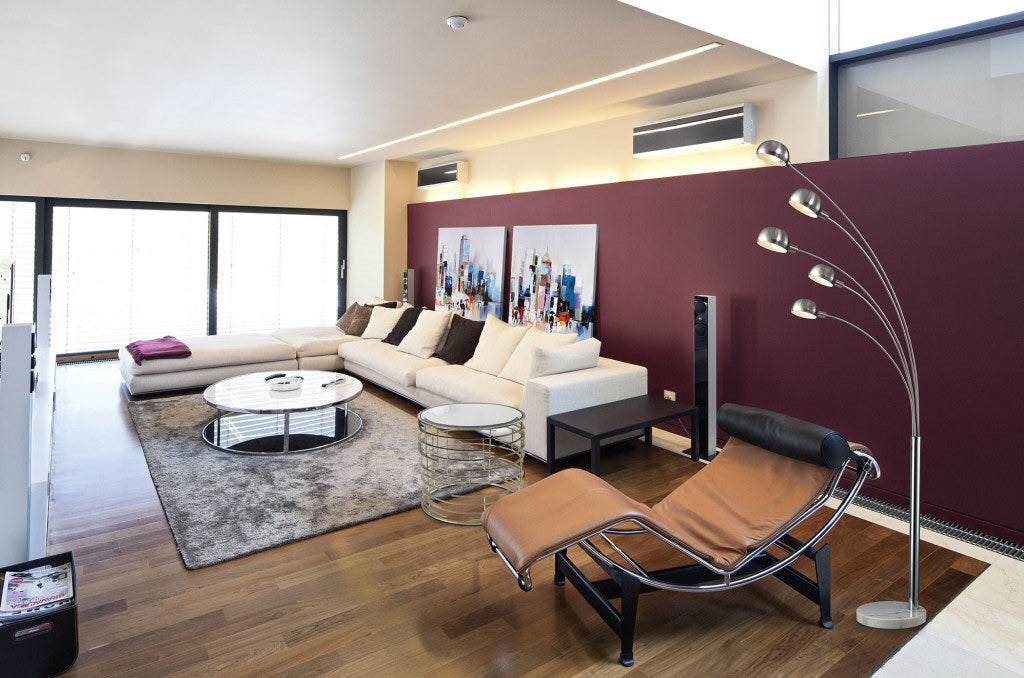
There are numerous possible ways to light a larger room. The extra space sets your creativity free!
Whether you'll focus on several of the same type of light fixture, or a combination of two or thee types of lighting, it depends on the style of your room and what practical functionality the room must serve.
Things to keep in mind in a larger living room
- The more distance there is between the light source and the objects or people it illuminates, the dimmer it may appear to be
- Light spreads out (diffuses) as it travels further and bounces off objects, causing it there to be less-focused light in each location
- It will be more difficult to make a single light fill the whole room, or reach to all the walls and corners
- You can always move furniture away from the walls and towards the center of the room in order to bring them closer to where the light fixtures are
- You'll have difficulty lighting a larger room entirely with portable lamps. A larger room really calls for at least one or two significant light fixtures
- A larger room with a tall ceiling will struggle to bring light all the way down from the ceiling level to the floor. Ideally, you'll use some kind of hanging lights like chandeliers or pendants rather than close-to-ceiling or recessed lights
- While more light fixtures may be needed to raise the overall level of ambient light, you will very likely need at least one or more lamps or low-hanging light fixtures for task lighting, such as next to a chair or over a table to bring a focused "hot spot" of light into the room, otherwise people may find there to be not enough light for practical activities
- Smaller light fixtures in a larger room will not look correct. Try to keep things in proportion to the room size. A larger room generally needs larger light fixtures and lamps
- You can distribute the light better through the room by using multiple smaller light fixtures, for example several pendant lights hanging from the ceiling rather than one large centralized fixture
- If you have the head-room, hanging a ceiling chandelier is an excellent choice. They provide numerous light bulbs in close-quarters and add a magnificent stylistic highlight to your interior design. Chandeliers are highly decorative centerpieces, also excellent in dining rooms, kitchens, foyers and bedrooms
- If your living room is part of a more open floor-plan layout, consider how your lighting can also share with other parts of the overall space because now you are sharing light between functional areas
Our recommendations for creating stunning lighting in a larger living room
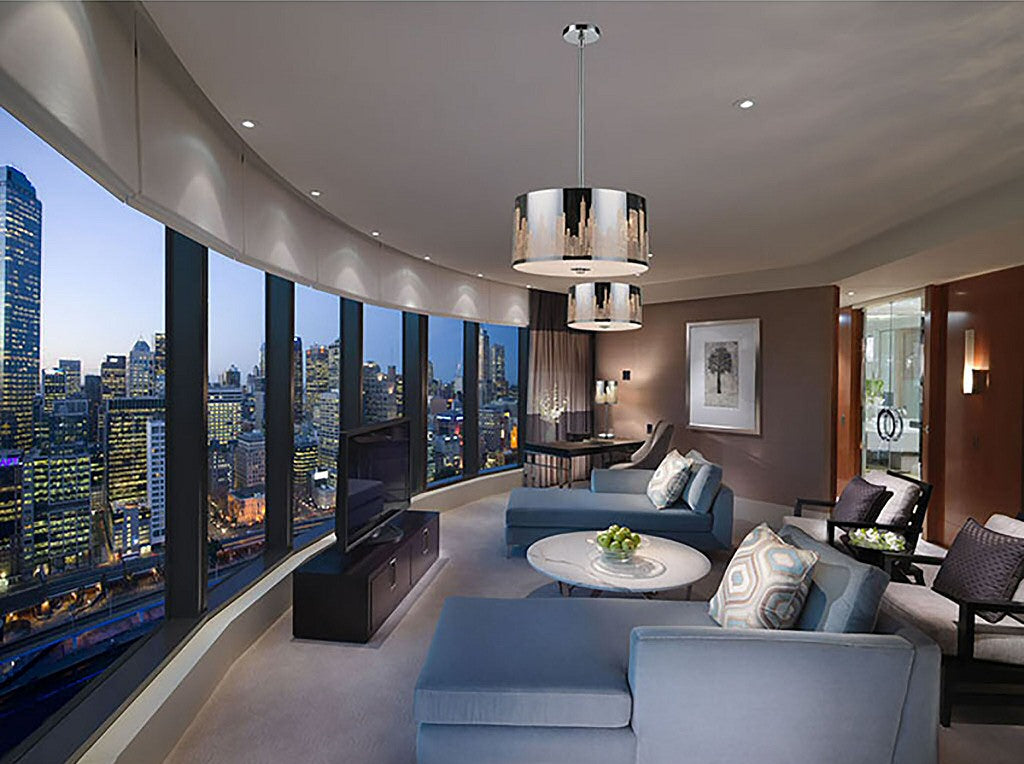
You can use light fixtures and/or lamps in various combinations. Below are some popular lighting layouts for a bigger living room which you may be able to adapt or build upon.
Unless you are going to equip your larger living room with several lamps, you likely will need to have light fixtures installed by an electrician.
But remember that swag pendant lights and plug in wall lights are an option for an electrician-free setup, providing light fixtures without the extra hassle. Here are some popular living room lighting ideas:
Option 1: A chandelier, wall lights, table lamps
Ambient lighting: Contributed to by all of the lighting types, mainly from the (A) chandelier and (B) wall lights.
Task lighting: (C) Table lamps.
Ideal for: A room with a taller ceiling to accommodate a chandelier, and featuring some seating areas.
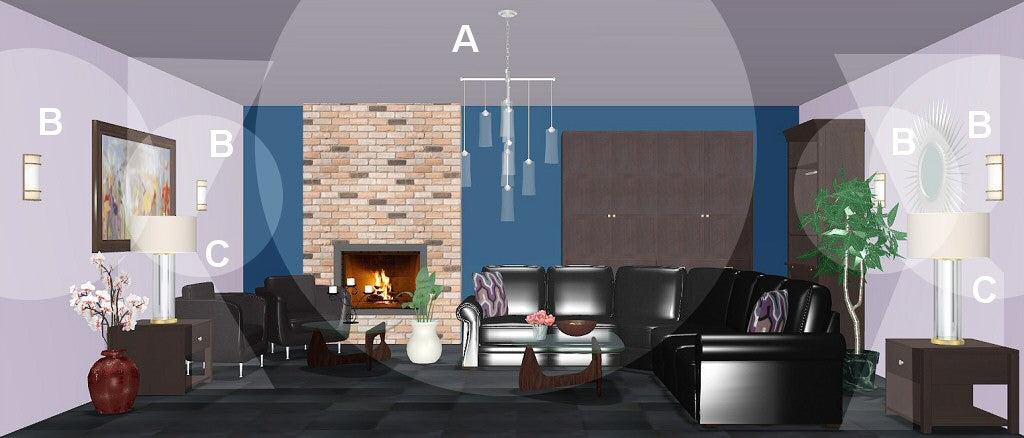
In this simple arrangement, you will light the majority of the room with a larger chandelier featuring 6 or more lights. If your room is especially large you may be suited to using 2 or more chandeliers.
While very large chandeliers with 12 or more lights can be magnificent, they will cluster most of the light around a fairly confined area which may not spread well throughout a significantly larger room. The larger the room is the more we would suggest breaking up the lighting into separate fixtures.
The central chandelier will provide a gorgeous centerpiece in any large living room and will fill the room with ambient light from above.
Secondly, place wall sconces along mostly-bare walls. A wall sconce will provide additional ambient light which is fairly confined to the area near the wall, as well as lighting the wall itself in a decorative way, reflecting diffused light off the wall. Depending on the size of the room, you may need at least two wall lights if not several.
Then in order to bring brighter light closer to seating areas, add table lamps on convenient side-tables next to chairs or couches. You'll want the lamps to be closer to where people will spend most of their time
A table lamp with a classic empire (pyramid shaped with open top and bottom) shade will help to spread light out beneath the lamp to shine onto the chair, and thus onto the lap of the person sitting there.
Examples of Chandeliers Examples of Wall Lights Examples of Table Lamps
Option 2: Pendant lights, floor lamps, desk lamps
Ambient lighting: (A) Pendant lights and (B) floor lamps.
Task lighting: (C) Desk lamps.
Ideal for: Positioning downward bright light over seating areas or in the main body of a taller room, then providing functional lamps for occasional use.
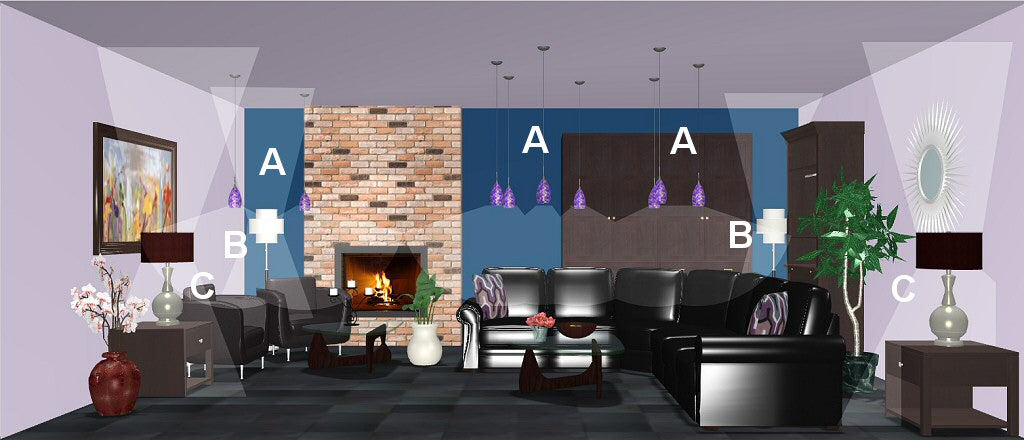
Pendant lights are versatile in that they can be hung at varying heights. This is true of chandeliers also but a chandelier also has a large body and so needs extra room.
You can hang a pendant light nearer to or further from the ceiling, or at different heights for artistic effect. Several pendants can work together, perhaps with different colored shades or designs. A pendant typically features only one or a few light bulbs, so you will likely need more than one.
It will create ambient light in a fairly local section of the room, particularly if the shade reflects the light upwards. If the pendant is more downward-facing, it will reflect most light below, producing a brighter light for people, and so can for example be a good idea over a seating area or table.
To complement the downward pendant lights, add some upward-facing torchiere floor lamps or floor lamps whose shade directs light upward and downward. These will shine ambient light toward the ceiling and diffuse it further into the room, as well as possibly providing downward light near to a seating area.
To provide more focused local light when needed, add some adjustable desk lamps on side tables next to seating areas so that humans can use a brighter light when needed. This can be useful for reading or other activities.
Examples of Pendants Examples of Floor Lamps Examples of Desk Lamps
Option 3: Close-to-ceiling or recessed lights, spot lights and table lamps
Ambient lighting: (A) Ceiling lights
Task lighting: (B) Spot lights and (C) Table lamps
Ideal for: Living rooms with lower ceilings
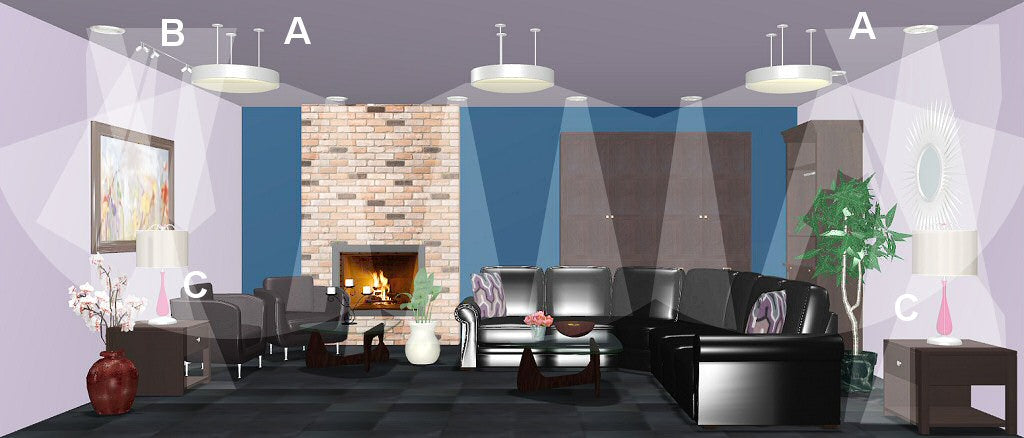
When you haven't got the height available for a hanging light fixture, you can always look to fixtures which hug closer to the ceiling. This includes semi-flush-mounted ceiling lights, fully flush-mounted lights (dome lights), recessed lights and ceiling or wall-mounted spot-lights.
A flush or semi-flush fixture will live near to the ceiling, with or without a gap between the ceiling and the shade. These simple lights typically house up to 3 bulbs, so for a larger room you may need a few of them. They will usually output diffused ambient light unless you opt for a fixture with spot lights or downward-facing exposed bulbs.
Recessed lights sit "inside" the ceiling, with very little external fixture showing. This is great if your ceiling can accommodate such lights and keeps the room free of protruding objects. Note that such lighting is quite downward-pointing so will highlight a fairly local area, and being distant from the area may not produce bright enough light for tasks. Recessed lights are fairly inexpensive since they don't feature much in the way of a decorative body.
Spot lights can be a good option for a lower-ceiling room because you can either mount them on the ceiling or high up on a wall. They allow you to customize where the light is directed since they output a narrower cone of light, so you can aim them at significant objects or seating areas.
Note that since they are distant from the target, they require strong light bulbs, otherwise you'll have to accept them as a semi-ambient light source - good for illuminating an area but not for when you need a brighter local light. You could of course aim more than one at the same area.
To bring a stronger light to the lower areas of the room, opt for some table lamps sitting next to seating areas. This will complement the general overhead lighting and help users to see better when reading a book or working on seated activities.
Examples of Ceiling Lights Examples of Spot Lights Examples of Table Lamps
Option 4: Ceiling fans with lights, wall lights and table lamps
Ambient lighting: (A) Ceiling fan with lights and (B) wall lights
Task lighting: (C) Table lamps
Ideal for: A living room or family room you'll "live in" more of the time, especially in a hot summer
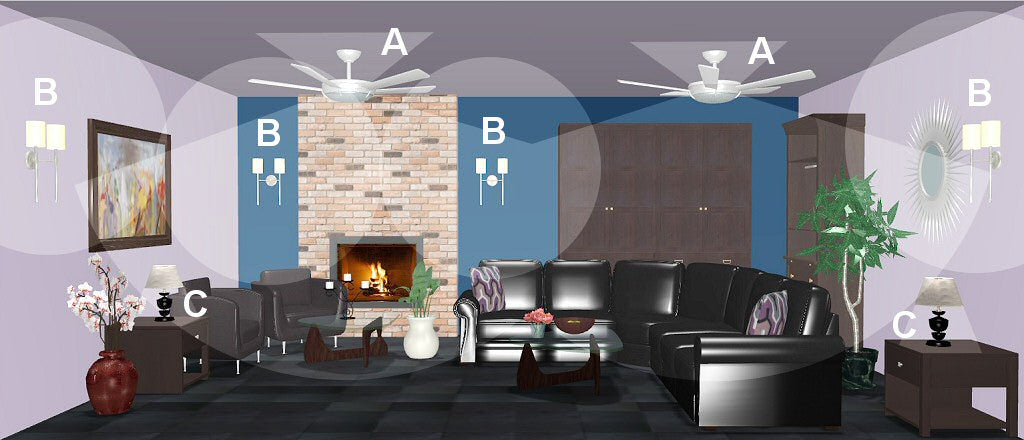
There's nothing quite like a cool breeze from a living room ceiling fan in summer when you need to cool down or keep out of the heat. Ceiling fans provide this extra air circulation, can help with your heating bills in winter, and are a must-have for any location where the summers are uncomfortable.
Fans come with or without lights but many can also be adapted to accept a "light kit" which usually attaches under the fan. These provide up to 4 light bulbs and usually radiate light downwards. This can be helpful especially positioned over a seating area where you are receiving both light and airflow.
A fan can substitute for a central room light but in a big living room you'll possibly need more than one, or you will need to complement the fan with some other light fixtures. This is where wall lights come in. Add wall sconces, wall brackets or swing-arm wall lamps. You can also obtain wall lights which plug in to a regular wall socket.
A ceiling fan will struggle to distribute light throughout an entire room so lighting on the walls is a great way to balance the light throughout the room. A wall light can also be stationed near to a seating area to help there. You will likely need at least a couple of wall lights if not more depending on the room size.
Finally, opt for some table lamps positioned near to seating areas to help bring extra light. Depending on whether your ceiling fan light is directly over seating or not, you can either place table lamps next to the seating, or as a secondary lighting option while seating, or in corners of the room to bring light to those area that the fan light doesn't reach.
Examples of Ceiling Fans
Examples of Wall Lights
Examples of Table Lamps
Option 5: Swag pendant lights, floor lamps and table or desk lamps
Ambient lighting: (B) Floor lamps and (A) pendants
Task lighting: (B) Floor lamps and (C) table or desk lamps
Ideal for: When you cannot or would rather not install hard-wired light fixtures, to save expense or to make your lighting more portable and rearrangeable.
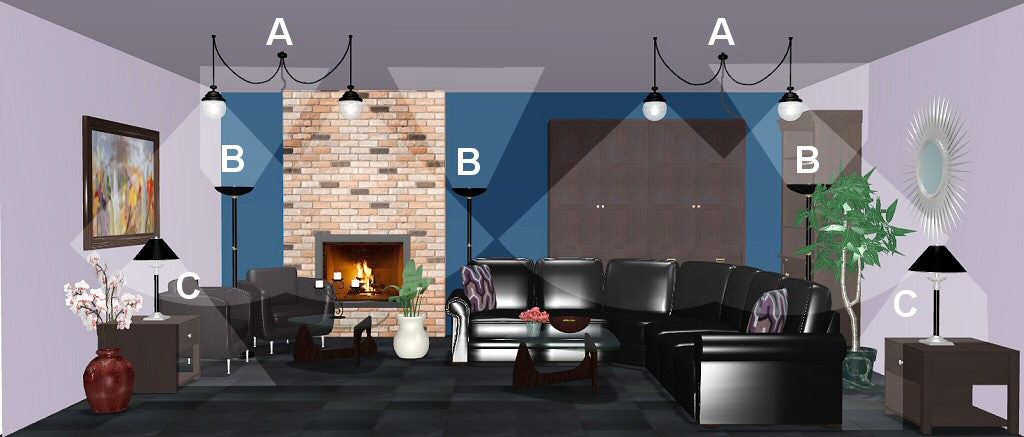
A great lighting setup is to use entirely portable lighting. The great benefit here is the flexibility - when you get bored and want to rearrange your room, you can literally move your lights wherever you prefer to suit your new layout. You can also experiment within "living in" the room over time to see if the arrangement suits your needs, and later make modifications to position.
Another significant benefit to portable living room lights is not having to hire and pay an electrician. This makes installation far quicker, you can take your lights with you if you move or move them to another room, and you can be up and running in no time. Not to mention, if you don't like where the light ended up, you can always move it.
Using a plug-in pendant light or swag light, you can drape the chain or cord across a couple of ceiling hooks which are easy to install and make minimal disruption to the room's surfaces. It then simply continues down a wall and plugs into a regular electrical outlet. This means you can also place the lights on a dimmer switch if desired.
A swag pendant light can also then be adjusted, height-wise, lowered closer to a chair or table or raised up depending on your needs. These versatile hanging light fixtures complement most styles of rooms and can double as either producing ambient light or a more focused light in a specific area.
Secondly, add two or more floor lamps to the room. These tall lamps will be out of eye-level sight when people are seated, provide brighter ambient light and help to fill the room with light. They are a great complement to the hanging swag lights and will bounce light off the ceiling. A floor lamp may also be positioned near to seating to provide nearby downward light.
For even more practical local light, add some table lamps or desk lamps next to chairs or either side of a couch to provide bright nearby light for tasks and activities. When someone is seated to read a book they may need light over the shoulder or next to them, on a side-table or end-table, and so work well with the rest of your living room furniture.
Examples of Swag Pendants Examples of Floor Lamps Examples of Table Lamps
What about lighting ideas for a small living room or study?

There's lighting options suitable for a smaller living room as well. Below are the best lighting for living rooms that are small. The best lighting options for living rooms are also often less expensive.
Floor lamps

A floor lamp can sit in a corner or behind a couch or chair and provide relatively bright light, usually are brighter than table or desk lamps and you can read by them. They provide ambient light for the whole room but also localized near to a seating area.
Tucked in a corner of a room they also work well to light the whole room. Some of the modern LED floor lamps now feature bright lighting in a very minimalist design that takes up barely any space.
Floor lamps tend to be much brighter than other types of lamps so can help to light the whole room.
Desk lamps
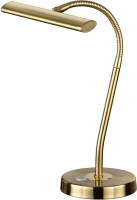
If you have a desk or side table in the room, a desk lamp is a good option. They generally take up less space than a table lamp, are often adjustable and easily positioned to bring the light near to where you want it, and can sit out of the way when not in use.
A full spectrum desk lamp is also great for reading, crafts and hobbies and is easier on the eyes. Modern desk lamps may also feature long-lasting LED light bulbs.
A desk lamp makes an interesting alternative to a table lamp in a living room.
Buffet Lamps

A buffet lamp is a type of table lamp designed to fit on a narrower table. They tend to be proportionately taller than a regular lamp and also narrower in design.
Tall and slim buffet lamps will take up less space in the room and can sit on a side-table or at the edge of the room or in a corner, taking up a lot less space and keeping within the confines of the furniture.
A buffet lamp will also work well in a narrow space like in a hallway.
Flush ceiling lights or recessed lights

To get a strong ceiling light into a small room you don't really want a lot of bulk hanging down. A small room probably doesn't have a high ceiling. So move the light closer to the ceiling. You can do this with a flush-mounted or close-to-ceiling fixture.
Or if you want to totally get the light out of the way, put in some recessed lights. These will act like strong spot lights aiming downward, so won't produce as much ambient reflected light, but can highlight important areas.
Spot lights and can lights
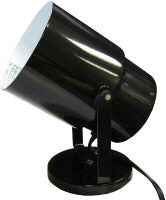
Lights which don't take up much room themselves include spot lights and up-lights. A spot light can attach to a wall or ceiling and be aimed exactly where you need the light.
A can-light or up light is like a small cylinder which you can sit on the floor or behind furniture or in a corner to shine light upwards.
This will produce mostly reflected ambient light and is more decorative. Note that a spot light is probably not an ideal substitute for a lamp positioned near to where you need the light.
Wall lights
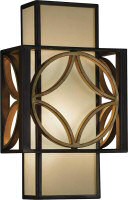
Wall-mounted lights tend to be quite small in terms of size and in their extension into the room. Particularly you can look for ADA certified (American Disabilities Act) wall lights which are designed with a low extension so as to not protrude into the room too far, and will sit flatter to the wall.
Also look for a "wall sconce" or "wall pocket" which tend to sit closer to the wall than a wall bracket or swing-arm wall light.
A couple of wall lights in a room will help to provide ambient light. You could also opt for a swing-arm wall light, tuck it away when not in use, and swing it out over a chair when needed.
Mini Pendant Lights

Mini pendants usually feature quite small glass or metal shades which hang down from the ceiling. Usually no wider than 8-10 inches across, they take up very little room.
Ideally hang one or more mini pendants over a seating area or table to light that area of the room. While you can certainly get away with a regular pendant light in a small room, mini pendants offer the smallest possible hanging-light option.
Now for the Top 20 most POWERFUL lighting solutions for your living room!
We will now feature the 20 best interior design ideas for improving the interior lighting of your living area or family room!
We have grouped these into 3 sets - ambient lights for general lighting, localized task lights for short-range activities, and accent lights for decoration.
The best living room lights for creating ambient light
1. Living room Chandeliers

A chandelier can be a central masterpiece in your living room. Especially beautiful and intricately designed, these magnificent light fixtures have a long history and are still popular today in a wide range of styles, ranging from traditional to ultra-modern.
Chandeliers typically feature a central column or pivot out of which multiple arms spring, each featuring an individual light. At least, that's been the tradition.
With modern LED chandeliers, the LED lights now make it possible to explore exciting new designs and break the mold through interesting shapes and large numbers of small lights.
The benefits of placing a chandelier in the living room
- Provides a "full" light source with many lights that contribute to ambient light throughout the room. Especially chandeliers with multiple tiers they can help to light the top and lower portions of the room.
- Creates a lot of ambient light from reflected surfaces like ceilings and walls
- Beautiful designs and a long history contribute to making a statement in the room, defining a theme and complementing your decor
- Many light bulbs means a larger overall light output helping to brighten the room
- Visitors to the room will likely say "wow" as soon as they feast eyes on your unmistakable centerpiece
- Particularly well suited to great rooms with high ceilings or vaulted ceilings
- A chandelier provides a high total amount of light output for a room, gathered around a central area. Its light can fill a whole room, but it may be a good idea to accent it with other types of lighting as well. Especially if you want a lower level of light in the evening
Expert living room chandelier ideas
- If your room is quite large you can complement the chandelier with wall lights, or use 2 chandeliers together in a longer room.
- Another good complement for a chandelier are some table lamps especially if your seating tends to be away from the center of the room and you don't always want the big light switched on.
- Bear in mind, to place a chandelier in a living room you'll need to have ample ceiling height, particularly if you plan to walk beneath it. In a dining room you can get away with hanging it over a table so don't forget to leave room for people to walk around.
- Keep your chandelier(s) in proportion to the room size, a larger room needs a larger light fixture or it will look strange. Similarly a small room will be cramped by too large of a light fixture.
- If your living room has a good-sized table, a chandelier could be well-positioned above it
- You can always swing from your chandelier when you're partying (don't try this at home kids!)
Look at some chandeliers
2. Living room Floor Lamps

Floor lamps make a great living room light for several reasons. They feature quite bright bulbs usually, brighter than table lamps, often in the 300-watt range or equivalent. This helps to raise the ambient light in the room.
A floor lamp will disperse the light upwards and/or downwards and possibly out sideways depending primarily on the design of the lampshade. Reflected light off the ceiling by a torchiere floor lamp can diffuse the light further.
A good floor lamp can also be positioned near to a chair or seating area to provide downward light for reading etc.
The benefits of living room floor lamps
- Relatively inexpensive compared to light fixtures
- Provides upward light which reflects off the ceiling as diffused light, increasing the overall ambient light in the room
- Can be easily portable and moved to another area or room
- 3-Way switches make it possible to easily change the light level, or use a modern dimmable led floor lamp for ultimate control
- The decorative shade is pitched at eye-level when standing so as to shield your eyes from the bright glare of light
- They take up little floor space and so can be positioned behind a couch, in a corner, or next to a chair
- Many decorative designs are available ranging from ultra modern LED through to traditional stained-glass tiffany floor lamps
- Can also provide a reading light when sitting nearby or via a reading arm
- The decorative shade can be used as part of the room decor theme or to complement the living room color scheme
Expert living room floor lamp tips
- A floor lamp is great in an apartment living room or rental property where you can't install light fixtures
- Floor lamps usually provide more light than other types of lamps
- A full spectrum floor lamp offers a natural daylight-simulating light which is great for reading and lights the room in its natural colors
Look at some floor lamps
3. Living room Pendants and Swags

A pendant light hangs from the ceiling and usually features a single shade, housing up to 3 light bulbs. This light may be directed upward or downward depending on the shade orientation.
When aimed upwards, a pendant light will produce ambient light reflected off the ceiling. This keeps intense light out of the eyes of onlookers and contributes to the overall light in the room.
When aimed downwards or when the light is shone through a bowl or other shades in a downward direction, a pendant light fixture sends more of its light below. This is useful for more practical purposes such as highlighting an area of the room, bringing bright light over a chair or table, or making sure that the light is not as diffused.
The benefits of living room pendant lighting
- Bright light with up to 3 or so regular bulbs
- Can be hung at various heights
- Can be hung over open space or over a table or seating area
- Multiple pendants can be used together in a larger room
- Pendants are decorative light fixtures so can be used to set or complement a room theme or add color to a room
- Well suited to a room with a higher ceiling unless hung over an area where a person won't be walking around
- Can be implemented as a swag light. Plug in pendant lights can hang from simple hooks and be plugged into a wall outlet, avoiding the expense of an electrician and are portable and movable
- Generally not as expensive as chandeliers
- Can make your living room more unique as an alternative to a chandelier
Expert living room pendant tips
- Hang pendants in a row in a longer living room to distribute the light
- Pendants are available as "mini pendants" which usually feature a single bulb and often are quite small. Arrange several together to form a more interesting lighting solution. Otherwise alone they will not provide enough light for a whole living room - but could work well over a kitchen counter or bar
- Unique pendant lights are available now that LED lights have become integrated into the form of light fixtures. This provides for interesting new cutting-edge designs where you don't even see traditional light bulbs
- Hang a pendant over a chair for strong overhead lighting when seated
Look at some pendant lighting
4. Living room Wall Lights

Wall lights serve at the edges of a living room to add extra ambient light and add interest to a flat wall area. Light is often reflected against the wall and this helps to decorate the wall or break up mundane flat areas.
Wall lights are a great complement to other types of light fixtures elsewhere in the room. Light doesn't always reach to the edges of a room and a well-placed wall lamp can help to flesh out the overall light balance. Pair them up with a chandelier or pendant light for beautiful lighting teamwork.
The benefits of living room wall lights
- Wall lighting complements other light fixtures and creates ambient lighting
- Wall lights don't take up much room and don't interfere with human traffic
- They also serve as decorations on a wall which may otherwise be plain or bare
- With usually one or two light bulbs, wall lights raise the overall light level, but you may need two or more for best effect
- Provide a nice accent piece to build up the theme of a room
- Can be put onto the same circuit as your main light fixture so that they switch on all at once, or kept apart as a lower-level ambient light for evening atmosphere
- Are relatively inexpensive given that they usually feature mostly a shade and a small fixture and so are minimally decorative
Exeprt living room wall lighting tips
- Wall lights are often quite similar to bathroom vanity lights so don't forget to check out bath lights as well
- Position wall lights behind a couch for an increase in over-shoulder lighting
- You may want to place wall lights to the sides of or behind your field of vision when seated rather than directly in front to avoid glare
Look at some wall lights
5. Living room Close-to-Ceiling Flush Lights

Especially excellent for rooms with lower ceilings, a flush or semi-flush close-to-ceiling light in your living room gets mostly out of the way while placing strong overhead lighting above you.
Sometimes affectionately named "dome lights", you don't have to settle for a basic design. These lights are now available with decorative shades, and in particular the "semi-flush" ceiling lights bring the fixture a little further away from the ceiling in order to make room for a more decorative design.
The benefits of living room close-to-ceiling lights
- Great for a living room that doesn't have a higher or vaulted ceiling
- Provide quite strong overhead lighting with up to 4 bulbs
- Can be used in a group or in-line for a larger room, but you might find that a larger light fixture looks better in proportion to a larger room
- Great small living room lighting ideas where space is tight and you don't want a lot of bulk hanging in the way - you can then complement them with some lamps
- Are relatively inexpensive compared to larger light fixtures, they're a good tradeoff between ample lighting and decorative qualities
Expert living room ceiling lighting ideas
- Try to avoid the basic "builder" type of dome lights. These lack thematic style and can make your room look cheap. Yes they are less expensive but the reason is that not much thought is put into quality and style. You can do better!
- For a really cramped room you can also look into "linear" light bars which are often flat panels located at the ceiling
- While a few close-to-ceiling lights may work in a larger room you probably should opt for a more significant light fixture as the room size increases otherwise your lights will come across as too small for the room and may not light it sufficiently
Look at some close-to-ceiling lights
6. Living room Ceiling fans with Lights

Serving a dual purpose, what is more practical than a ceiling fan in your living room area? A fan provides better circulation of both warm and cool air, can help with your heating or air conditioning bills, and are very quiet to run.
Modern ceiling fans also feature light kit attachments which can give your fan a dual function. Since it is taking up space near the center of your room or over a significant seating area (best not to waste that cool breeze over a table), you'll want it to also double as a light fixture.
Some fans include "up lights" as well as "down lights" to provide ambient lighting, but mostly the down-lights will fill the room with broad ambient light centered around the fixture.
The benefits of living room ceiling fans
- Provide air conditioning and freshness (works great in combination with an air filter)
- Helps warm-risen air to move back down to where you need it
- Helps lift up warm air away from you
- Provides a lighting option at the same time (the light is usually separately controllable)
- Great for being positioned over a couch or chair
- Can light the whole living room in a small-to-medium sized room
- Well accented with a lamp or two
- Provides fairly bright light with up to 4 bulbs
- A bit more costly as a lighting choice, but brings a lot of extra benefits
- Come in various sizes and speeds/powers for different room sizes
- Many can be operated by remote control or a wall switch with various speed settings
Expert living room ceiling fan tips
- Remember you'll need room to move or walk below the fan. If it's over a seating area that's great. You can also get hugger fans which are much lower profile fans and don't take hang down as low as regular fans
- A larger living room may benefit from a large powerful fan or more than one fan
- If you want to feel the breeze, make sure the fan is closer to or above your seating area
- Watch your head!
Look at some ceiling fans
7. Living room Recessed lighting

Recessed lights work well in a modern contemporary living room. They don't protrude into the room barely at all and instead sit "recessed into" the ceiling itself. This means you barely notice them until they are switched on.
Recessed ceiling lights shine directly downwards and often feature a reflector bulb which is designed to aim all light downwards. This light does spread outwards but the light proceeds in a cone shape.
It will provide ambient lighting reflecting off objects and surfaces below, or directly illuminating them from above. But you will also notice hot-spots of lighting in the room when standing nearer the lights. You will also need more than one in any room to provide enough light since each light features only one bulb.
Photo copyright by Callum Mundine at LEDWorld.
The benefits of living room recessed lights
- Modern style takes up no room space
- Can be positioned in any arrangement you choose
- Provides fairly bright light but you may want other lamps to fill out the space further down in the room
- Position over a couch or seating area for maximum use of the semi-focused light
- Relatively cheap due to the total lack of decorative qualities and minimal design, which is good considering you'll have to buy several
- Look thematically relevant for modern living room living
Expert living room recessed lighting tips
- Lighting is from above directed downwards so helps to illuminate objects and surfaces below, but therefore you may need some lamps or wall lights to illuminate the "sides" of objects more
- Recessed lights can look cheap or non-decorative due to their extremely basic design so may not complement a more decorative or traditional room theme well
- Tying the light fixture to a single light bulb rather than one fixture with multiple bulbs may overall be less cost effective
- Complement your recessed lights with some lamps to bring local comfort to specific areas of the room
- Tend to isolate the light to an area "below" the light, so you'll need other ways to spread light through the room
Look at some recessed lighting
The best living room lights for task lighting
8. Living room Table lamps

What would a living room be without table lamps? You can certainly buck the trend by having a room with no lamps, but table lamps have been the staple of living rooms worldwide for decades.
A table lamp, suitably named given it typically sits on top of a table, side-table, end-table, chair side table or some other flat-topped furniture, features a decorative base and shade. Thus it contributes to the overall decorative theme of your room.
Different shade shapes and designs will direct light differently but usually a living room table lamp will flare outward at the bottom in order to direct most of the light "down and out", covering a larger area below than above.
Table lamps are well suited when situated next to a living room chair or sofa since it shines onto your lap to help you to read or perform crafts and hobbies.
The benefits of living room table lamps
- Traditional form of living room lighting, well established
- Suited to sitting on top of some other furniture piece
- Decorative and available in thousands of designs to suite every taste, color-scheme and living room theme
- Spreads light out from the bottom so works well next to a chair
- Work well as a pair to balance a room, place them either side of a couch or in corners of the room
- Keeps the light focused and local to the area next to where they are located, so are well suited as a practical light source
- Can "finish" a piece of furniture when paired with it
- Relatively inexpensive and easy to install with no electrician needed
- Portable, can be moved and rearranged or placed in another room
- Often become family heirlooms over the years, particularly the beautiful tiffany table lamps which feature hundreds of pieces of stained glass which illuminate when the lamp is switched on
- Sitting on a table-top they tend to stay out of the way of foot traffic, are not placed in areas where you would move, and so do not interfere with your regular flow around your furniture
- LED table lamps are becoming more readily available and can save you money
Expert living room table lamp ideas
- Use two lamps together to flesh out a thematic style in your room
- Match the decorative color of the lamp to the color scheme of your room (or in a complementary way) to bring out accent colors
- Look for a table lamp with a 3-Way switch if you want to be able to adjust the light level
- Some table lamps feature 2 light bulbs, most feature just one, but it may be up to a 150 Watt incandescent or equivalent
- Table lamps always have a switch but you can almost always place them on a lamp dimmer switch provided it will work with the type of bulb you use
- Contemporary styles may be less expensive than fancier or more artistic styles simple due to the amount of materials used, but match your lamp style to your room style or it will look out of place
Look at some table lamps
9. Living room Reading lamps

A reading lamp is a special kind of floor lamp well suited to a living room. The lamp features some form of downward-facing light which shines all of its light down onto some activity you are engaged in. Typically they are for reading but also can be used for crafts and hobbies or other seated activities.
Living room reading lamps can sit behind a couch or next to a chair and aim the light "over" the furniture. It then shines down from above and behind or to the side of you. You won't see bright glare of the light because it will be outside your visual window, and instead you'll benefit from light shining onto the surfaces you are engaged with.
Reading lamps are often adjustable with a gooseneck, may take the form of a "pharmacy lamp" with an adjustable height or with a swing-arm functionality that allows you to move them nearer of further per your wishes.
The benefits of living room reading lamps
- Take up relatively little space in your room
- Are relatively inexpensive compared to light fixtures
- Are portable so can be moved around or moved to another room
- Usually provide brighter light (upwards of 300+ watts incandescent) compared to other types of lamps
- Modern LED reading lamps now offer dimmable LED functionality and the flexible lamp body let's you place it where you need it
- An LED reading lamp won't need you to replace light bulbs, but a fluorescent lamp (its predecessor and still a popular choice) will
- Often provides "full spectrum" lighting which mimics sunlight and produces a more natural light. This makes for less glare, easier reading, is easier on the eyes and good for those with older eyes or poor eyesight. It also renders colors more natural which is great for crafting and hobbyists
- Gets out of the way and takes up little floor space
- Always features a switch and many are now dimmable or can be used with a lamp dimmer
- Long-lasting durable lights
Expert living room reading light tips
- Use your reading light for other purposes like crafts and hobbies too
- Remember you can move the lamp closer to you if it doesn't seem bright enough
- Makes a great gift for people of all ages and is highly practical
- You might think about avoiding halogen floor lamps because these older-design lamps get quite hot and the bulbs are difficult to handle or clean
Look at some reading lamps
10. Living room Desk lamps

A desk lamp is typically designed so that light from the lamp can shine downwards, but also so that this light is "off to the side" rather than being directly positioned over the lamp base. This means that the area below the lamp head is a clear desk or tabletop surface.
They therefore work great in an office or study but you can also use them in your living room. They are a great alternative to table lamps and are quite adjustable, making them versatile for a variety of uses.
Situate a living room desk lamp next to a chair or where you spend time, or on a side table or desk for those times when you need to sit and handle some paperwork.
The benefits of living room desk lamps
- Relatively small and adjustable meaning they stay out of your way until you need them
- Can be positioned and adjusted when you do need them to make them more effective
- They are a relatively inexpensive light source
- Usually contains only one light bulb or equivalent but allows you to put that light close to where you need it
- Various designs available
- Well suited on a living room desk or section of the living room being used as an office
- An interesting alternative to using table lamps
Expert living room desk lamp tips
- Place a desk lamp a little higher on furniture or a shelf to allow for over-the-shoulder lighting
- Remember they're adjustable and portable and they adapt to where you are, making them quite useable and friendly
- Desk lamps are typically used for activities/tasks so may not serve quite so well as general lighting, and you might want to switch them on and off when you need to them rather than being on all the time
- LED desk lamps are becoming very popular, save energy and money and last far longer than previous desk lights
Look at some desk lamps
11. Living room Task and Craft lamps

Sometimes your living room is a great place to perform crafts and hobbies and various other intricate activities. For this you need a good strong light without too much glare, accurate color representation and some degree of flexibility. Here, task lamps and craft lamps come in handy.
Task and craft lamps for your living room include magnifier lamps which feature a large magnifying glass combined with illumination, adjustable desk lamps where you can position the head of the lamp where you need it and move it away quickly, and full spectrum desk and floor lamps which render colors accurately and are easier on the eyes.
The benefits of living room task lamps
- Provide focused light and clarity for your detailed activities
- Are usually adjustable and can be moved or positioned closer to your activities or from a certain angle in which you need to see things clearly
- Are relatively inexpensive forms of lighting
- Usually shine light in one direction so that you can work with the light from a specific angle
- Allows you to bring your creativity into the living room
- Modern LED lamps offer long-lasting bulbs now, provide bright light and can also be dimmable
Expert living room craft lamp tips
- A full spectrum floor lamp or LED floor lamp can double-up as a reading lamp and also be used for crafts and tasks and reading
- A full spectrum desk lamp is another short-range option for being able to see what you're doing clearly
- With full spectrum craft or task lamps they are easier on your eyes so you can feel more relaxed and strain less
- A magnifier lamp is great for the visually impaired but also for magnifying fine details as for when performing crafts activities, needlework and sewing, reading, creating jewellery etc.
Look at some task and craft lamps
12. Living room Full Spectrum lamps

A full-spectrum lamp provides a bright and "natural" spectrum of light attempting to mimic natural daylight.
The light is often quite "white" and so renders colors quite accurately. This helps details to stand out without distortions of contrast or color and so makes it easier on your eyes to read and perform tasks.
There are also some health benefits with the use of full-spectrum lamps such as helping to diminish seasonal-affective disorder (SAD). They're great for older eyes and make focused tasks much more comfortable and relaxed. It's almost like bringing the sunlight inside.
The benefits of living room full-spectrum lamps
- Provides clear and accurate light similar to sunlight
- Complements natural light coming in through windows
- Helps you to continue exposure to natural light regardless of season or short days when the sun sets earlier, affecting your circadian rhythm in a beneficial way
- Brings out natural colors in a balanced way, which affects how your living room decor appears
- Produces less glare and much less "yellow" light typical of incandescent bulbs
- Not much different in price from other types of light
- Fluorescent tubes are also available which produce full spectrum light and LED lights are now branching out into full-spectrum versions
Expert living room full-spectrum tips
- Combine full spectrum floor lamps and desk lamps with full spectrum bulbs placed in other light fixtures
- Full spectrum bulbs are available for screwing into regular light sockets so you can easily convert an entire fixture to use full-spectrum light
- Once you've spent time in full-spectrum light you may not want to go back to old forms of lighting!
- Placing full spectrum lights closer to humans/seating even in the presence of other types of light elsewhere in the room can help you to enjoy quality natural light in specific areas of the room
Look at some full spectrum lamps
13. Living room Smaller pendants and swags

Pendant lightsare versatile and can be used either to light a large part of the room or to focus light on a specific area. If you take a pendant with a downward-facing shade, it will direct the light downward in a cone shape.
This can be placed over a chair or table to light that specific area in a focused way, making it easier to see to perform tasks or activities in that part of the living room.
A pendant can also be installed at various heights with an adjustable chain or cord, allowing it to adapt to the terrain of your furniture.
Mini pendants should also be considered - these typically are no wider than 6-8 inches and often feature colorful glass shades. They provide a small area of light and so can be used to highlight specific areas of the room or over a certain feature or seating area.
Additionally, if you cannot install a pendant or pendants you can opt for a plug-in swag pendant. This simply hangs from simple hooks in the ceiling which are easy to install, and then drapes across to the wall and continues down the wall to a regular plug socket. You can hang a swag light over or near to a sitting area in your sitting room to highlight the area.
The benefits of living room pendant lights
- Provide a semi-focused light in one part of the room
- Can aim light downwards and outwards in a specific area
- Usually provide 1-3 light bulbs to focus on an area
- Can be hung at different heights to adapt to your living room furniture
- Are often colorful featuring colored art glass or even stained glass
- Are available in a wide variety of styles and designs to match your decor or to help establish a decorative theme
- Are mid-priced and more affordable than chandeliers
- Can highlight an area where you perform tasks or crafts or activities in the room
- Can also serve as a central light fixture for example above your coffee table
Expert living room pendant tips
- Hang a collection of smaller pendants together for artistic effect
- Place a few pendants in a row in a longer room to light the whole room
- Hang a pendant over your favorite chair to really highlight the area
- Make sure to measure how much headroom is needed above the light, both while sitting and while standing up from sitting, to make sure you won't bash your head on the light fixture
- Pendants work well in rooms of any height but particularly are suited to great rooms or living rooms with higher ceilings
Look at some plug in pendant lights
14. Living room Swing-arm Floor lamps

An often overlooked opportunity in living room interior design is the use of a swing-arm lamp. These lamps are not quite as popular as they used to be but these "pharmacy lamps" feature a hinged arm which allows the head of the lamp to swing out to different positions or be tucked in closer to the lamp.
This allows the lamp to sit next to a chair or desk and be positioned out over the work surface or seat to shine focused light on that area. They are often quite classically styled lamps which add an elegant touch to your living space.
The benefits of living room swing-arm lamps
- Usually feature an adjustable height lamp base which lets you raise and lower the height of the lamp head
- Usually feature a hinged arm with elbow that allows you to move the lamp head closer over your work or activities and back again with ease
- They get out of the way when you don't need their services
- Add extra class to your room
- Often coordinate well with a more traditional or luxurious room theme
- Are relatively inexpensive and a good way to highlight an area you use
Expert living room swing-arm lamp tips
- Put your lamp next to a chair or couch so that you can swing the light over your lap when needed for reading or eating etc
- Place the lamp next to a living room desk or roll-top desk so that you can use it to read paperwork and perform other important tasks
- Adjust the height to what is comfortable for you when seated so that it does not glare in your face and leaves enough room below for your arms to maneuver freely
Look at some swing-arm floor lamps
15. Living room Swing-arm wall lights

A complement to a swing-arm lamp is a swing-arm wall light. Often overlooked in any room, these classic light fixtures are installed on a wall and typically feature a lamp shade covering a light.
The light and shade are on the end of a hinged arm which allows the light to be folded outwards when needed or tucked away.
A swing-arm wall light is excellent near to a desk or a chair where you'll spend time sitting, or even next to a table against a wall. You can swing the light out when you need it to shed light and push it back into place when you're done.
The benefits of living room swing-arm wall lamps
- Provide a double function of acting as a background light or as a focused light for activities
- Can be used to add ambient light to the room or as a task light
- Versatile and adjustable to position over a table or chair or desk when you need it and tuck away when you need more room
- Not really ideal for a hallway but perfect in a living room where parts of the room are away from walking areas
- Works well above or behind a couch or armchair or in the corner of a room
- Can be placed at any height on the wall depending on your needs
- Relatively inexpensive light fixture but does provide a decorative shade and so adds to the theme of the room
Expert living room swing-arm tips
- Be aware that even in the folded-in position the swing-arm light will still protrude quite far into the room, compared to regular wall sconces, and so you need to leave ample room in your floor plan to avoid walking into it
- One or two swing-arm wall lights may be all you need for supplemental lighting in a room that has other ceiling lights and lamps
- Can be a substitute for a floor lamp or table lamp or desk lamp if positioned well
- Since it's a hard-wired fixture it cannot be easily moved if you decide to rearrange your living room and want to move your favorite chair
Look at some swing-arm wall lights
16. Living room Piano lamps

If your living room features a grand piano or upright piano, a keyboard or even a computer, you might consider using a piano lamp or a banker's lamp. These adorable little lamps feature an elongated shade and one or two light bulbs which are specifically designed to output a "strip of light" horizontally.
When placed on top of a piano or over a keyboard, these lamps provide excellent illumination to see what you're typing or what key's your playing.
Affectionately named "piano lamps" they are literally designed for use with a piano and make for a functional and useful task lamp in the home.
The benefits of living room piano lamps
- Shines a wide horizontal area of bright light downwards over a piano or keyboard
- Perfectly designed specifically for use with a piano or keyboard recognizing your need to have the entire width of instrument illuminated
- Easy to switch on and off
- Inexpensive task light for a dedicated purpose - can be used as an accent lamp
Expert living room piano lamp tips
- If you can't find a piano lamp you like, try a banker's lamp. They are very similar in design featuring a downward shade often used on a desk to highlight the area below and can double as a lamp over a piano
- Check what kind of bulb the lamp requires and how bright it is to get a sense of whether it will be bright enough to light the area
- Consider switching out the bulb for an LED or compact fluorescent bulb if you have the room to accommodate it, because these bulbs require less wattage and so you can use a higher-output bulb and still stay within the electrical safety limit of the lamp's maximum wattage rating - never use a bulb rated at a higher wattage than your lamp
Look at some piano lamps
The best ways to add decorative accent lighting in your living room
17. Living room Accent/novelty lamps

While the most important aspect of living room lighting is to create enough light and to put the most important light in the most important areas of the room, the overall atmosphere and look of a room can be greatly enhanced with some accent lighting.
Accent lamps are typically quite small lamps, smaller than a typical table lamp. They are usually highly decorative and often feature beautiful tiffany stained glass which illuminates with gorgeous colors when the lamp is switched on.
These adorable little lamps will usually feature a very low wattage bulb - like a 7 watt incandescent candelabra bulb - and so are not so much a significant light source. They are more decorative and particularly come to life in the evening or used as a night light.
Accent lamps can be used to flesh out the finer details of lighting in a living room and to break up the room with attractive highlights.
The benefits of living room accent lamps
- Beautifully decorative they also make wonderful gifts and are usually quite small and easy to ship
- Add an accent to a room, even a work of art, to become a talking point
- Can be considered treasures and being small can be placed on almost any furniture, even on a mantel piece or shelf
- Look great sitting on an office desk as a little decorative detail
- Break up the monotony of larger empty areas of wall space
- Add a soft atmosphere-building glow in specific areas of the room
- Are relatively inexpensive, although the tiffany accent lamps can be a little higher priced due to craftsmanship involved in creating them
Expert living room accent lighting tips
- Place an accent lamp on a side table or mantel to show off the area and draw attention to it
- It's always fun to switch an accent lamp on because it's a work of art
- They're cute and add a delicate finishing touch to a living room
- They can double as a night light due to their low level of light output and so work great in any room of the home
- Place them in a window sill to show off to the neighbors!
Look at some accent lamps
18. Living room Up-lights

Up-lighting or can-lighting entails a small, usually cylindrical canister, with a single strong light bulb which shines light out of the top of the unit.
The can light is designed to sit on the floor or low down in the room, perhaps either side of a fireplace or alongside the television.
Light shines upward in an elongated narrow funnel shape and will reflect ambient light off the walls and off the ceiling.
Placed near other objects like house plants they can create interesting shadows projected onto the ceiling to add extra interest to a corner of a room.
Some of the light is also typically reflected off the wall and up-lights are a good way to break up a blank wall area and to create additional tones of color similar to your wall color scheme.
The benefits of living room up-lighting
- Small and inexpensive
- Highlight a specific area of the room similar to a spotlight
- Create some ambient light through reflections off walls and ceiling
- Can "decorate" other furniture by being placed alongside them, such as next to a fireplace
- Can brighten corners of a room
- Can be placed behind furniture out of sight
- Could also be used with a dimmer switch since they plug into a regular electrical outlet
- Create an interesting background from otherwise empty walls but in a subtle and attractive way
Expert living room can-light tips
- Place can lights next to furniture which is up against a wall to highlight the area
- If a certain wall or area of the room is dark, place the can light near that wall to reflect light into the room
- Can lights don't have to necessarily sit on the floor, you can place them on top of other furniture but beware they will show an electrical cord
- The exposed upward-facing bulb may collect dust and obscure some light so remember to keep them dust free from time to time. Collected dust on top of the bulb may "burn off" if the bulb is hot, producing some smell, so keep your lights dust-free
Look at some up-lights
19. Living room Spot lights

A fun way to highlight an area of your living room is with a spot light. Spot lights used to be more popular but they're still available. They can be placed on a ceiling or on a wall in any location, and feature the ability to be aimed in a wide range of directions.
Therefore you can use a spot light in your living room to highlight artwork, to create additional partly-focused light in a specific area, or to add accents to certain parts of the room that are otherwise dark or monotonous.
Spot lights are adjustable and can also be found attached to track lighting, allowing their position to be moved as desired. Even without a track, spot lights can be adjusted at any time to aim toward a different part of the room. But bear in mind their range may be limited.
A spot light is a great way to highlight something on your living room walls such as artwork or just to highlight the area to make your walls more interesting.
The benefits of living room spot lights
- Can be adjusted at any time to point in a different direction
- Ideally positioned near to a wall
- Inexpensive lighting
- May be better suited as modern living room lighting since they are not usually designed to look traditional
- Might be part of a track lighting system allowing for more versatility
- A good way to highlight walls or artwork on walls
- Can be placed lower-down on a wall to shine outwards into the room over specific areas
- Can be aimed to focus a beam of light towards a specific object, making it stand out in the room more
Expert living room spot-light tips
- Use a spot-light to accentuate artwork or to feature beautiful objects
- A few spot lamps working together can combine to create a brighter highlight
- If you get bored of your lighting you can adjust the spots to highlight a different area
- Can be used as a form of overhead lighting or as living room ceiling lighting ideas
- There's nothing stopping you from aiming a wall-mounted spotlight upwards towards the ceiling
Look at some spot lights
20. Living room Picture lights

To highlight your living room artwork on a wall, or to provide some lighting over a living room wall mirror, you can attach a small light fixture just above on the wall to shine focused light onto that one object.
Picture lights feature an elongated narrow shade which spreads the light out horizontally and aims to produce a reasonably wide window of light when the light makes contact with the wall-mounted art piece.
Some picture lights are also plug-in meaning that while a cord will hang down the wall, you can plug them into a regular electrical outlet. Others may require hardwired electrical installation.
The benefits of living room picture lights
- Designed specifically to highlight artwork or a mirror on a wall
- Can be shined onto a mirror - the light will reflect off the mirror onto your face
- Produces fairly even light to light your wall pictures
- Can be used with textured or 3D wall art or wall sculptures to add extra drama to the artwork through light and shadows
- If you have a particularly large wall hanging you might want to place 2 or 3 picture lights above, or couple them with some spotlights.
Expert living room picture-lighting tips
- Draw much more attention to some wall art by activating a picture light nearby
- Can be used with any kind of wall art including tapestries or woven art pieces
- The shade of the picture light might be adjustable to aim the light to your liking
Look at some picture lights
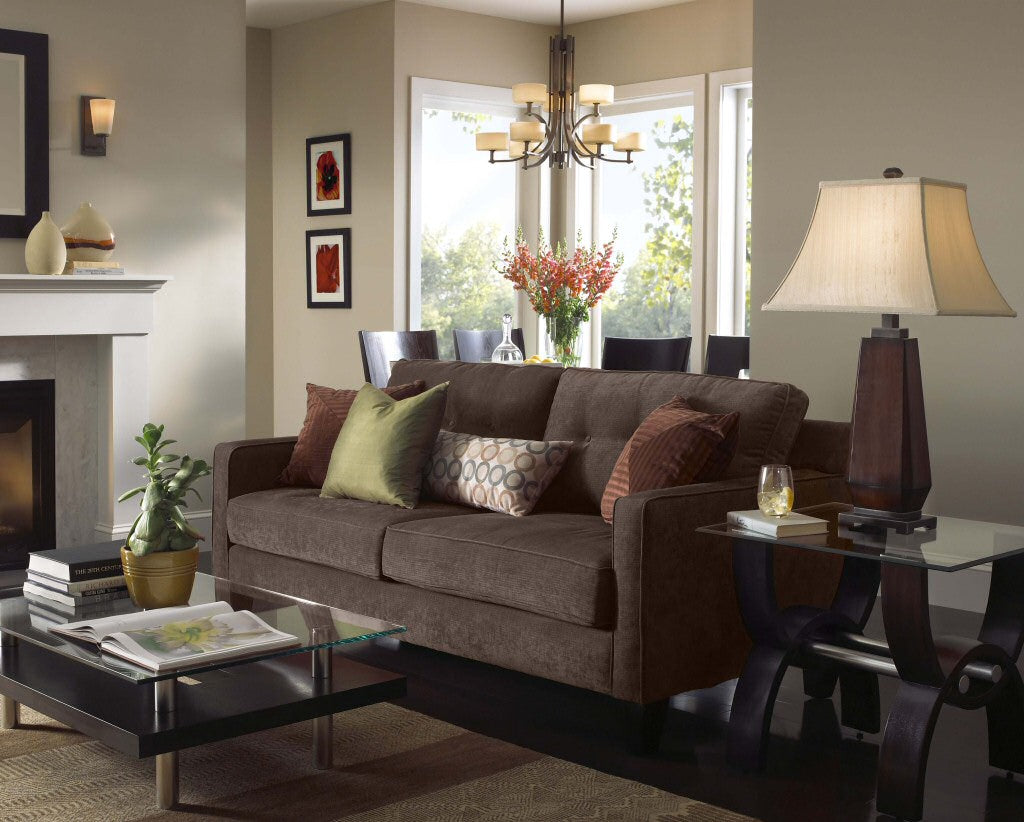
How to calculate exactly how much light you need in your living room
While it varies as to whether you want your room bright or more subdued, and how you plan to break up your lighting into separate fixtures or lamps, you can get an approximation of the required lighting needed for most living rooms.
- Measure the length and width of the room in FEET (one foot is 12 inches)
- Multiply these two measurements together in FEET. For example, a 10 x 12 foot room would be: 10x12 = 120 square feet.
- Multiply that result by 1.5, and you'll get roughly how much WATTAGE you would need to light the room.
- But bear in mind this wattage corresponds to incandescent light bulbs, and you will need to adjust the amount for other types of bulbs like fluorescent or LED bulbs because they produce the same brightness of light while using less wattage.
So the general formula is: Room length x room width x 1.5
Below are some examples of living room sizes and the amount of wattage needed to light the room.
Note that these wattages are for traditional incandescent lights bulbs.
Find the column corresponding to the length of your room on the top row, the width of the room on the left side column, and trace across to the cell where the row and the column meet - that's how much wattage you need (results have been pre-multiplied by 1.5 so are the final wattage needed).
For example a 16x12 room requires at least 288 watts of incandescent light. To produce an even brighter room, try adding on an extra 25-50%.
| x | 8 feet | 10 feet | 12 feet | 14 feet | 16 feet | 18 feet | 20 feet | 22 feet | 24 feet |
| 8 feet | 89.6 | 120 | 144 | 168 | 192 | 216 | 240 | 264 | 288 |
| 10 feet | 120 | 150 | 180 | 210 | 240 | 270 | 300 | 330 | 360 |
| 12 feet | 144 | 180 | 216 | 252 | 288 | 324 | 360 | 396 | 432 |
| 14 feet | 168 | 210 | 252 | 294 | 336 | 378 | 420 | 462 | 504 |
| 16 feet | 192 | 240 | 288 | 336 | 384 | 432 | 480 | 528 | 576 |
| 18 feet | 216 | 270 | 324 | 378 | 432 | 486 | 540 | 594 | 648 |
| 20 feet | 140 | 300 | 360 | 450 | 480 | 540 | 600 | 660 | 720 |
| 22 feet | 264 | 330 | 396 | 462 | 528 | 594 | 660 | 726 | 792 |
| 24 feet | 288 | 360 | 432 | 504 | 576 | 648 | 720 | 792 | 864 |
How to break down the wattage between multiple lights
Unless you plan on having a single light fixture or lamp fulfill your entire wattage needs, you will need to divide up the total wattage between multiple fixtures or lamps.
It may be a good idea
Focus on the main light sources first (most likely ambient light or major light fixtures), see how much wattage they will produce, and then fill in the rest of the wattage with additional fixtures or lamps.
Try to to have at least two independent "switches"
You can switch both types of light on together for a bright room, or switch one of them off for a softer and more relaxed atmosphere. This is why you should ideally use at least 2 distinct types of light in a living room.
Remember that accent lighting will not contribute significantly to the overall room illumination so is almost a freebie, but it will add some low level of light.
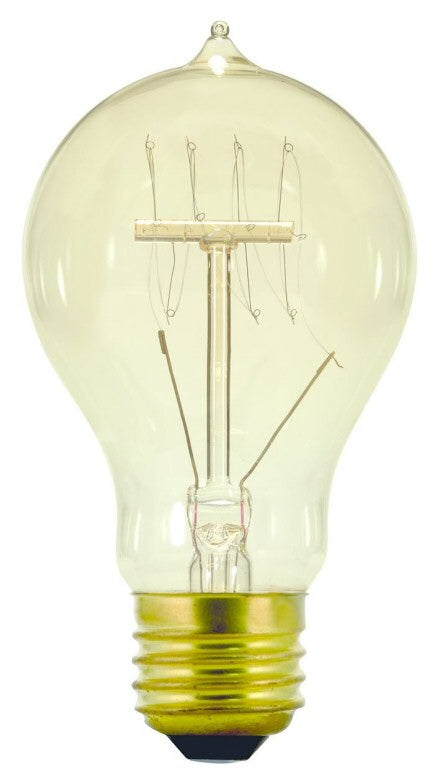
Be aware that not all lighting is equal
Remember that different forms of lighting, be they chandeliers or lamps, produce different shapes of light, different concentrations of light, different directions of light, and are used in different parts of the room reflecting off different surfaces.
Remember also that the more distance there is between a light source and some physical object being illuminated, the more the light diffuses and becomes dimmer
Lighting example
Installing recessed lights in the ceiling, trying to achieve your total wattage for a room, may miss the fact that lower down in the room light will be dispersed and someone sitting to read might not have enough light intensity nearby.
So try not to put all your eggs in one basket. Combine functionalities of light fixtures and lamps to accommodate differs horizontal areas of the room, and also different vertical layers of the room.
Two or three different types of light source is a safe bet to ensure there is enough light where you need it most.
Be aware of different types of light bulbs
Note that different lights will require or come with different kinds of bulbs and not all bulbs are equal.
While traditional incandescent lights are represented in the table above, fluorescent bulbs output the same amount of light from a lower wattage. Similarly LED bulbs use much less wattage for the same amount of light.
Therefore if you select lights which use fluorescent or LED or other lower wattage bulbs you will need to convert the wattage into an incandescent equivalent in order to make sure you are getting enough total light.
Converting from wattages to lumens
Another approach is to convert the incandescent wattage into LUMENS, which is a measure of the brightness of the light regardless of the technology of the light bulb.
This gives you another way to standardize the way you are measuring light. Then you can assess whether you have enough lumens for your room. To do this you will need to convert numbers in the above table to lumens first.
A 100 watt incandescent bulb gives off about 1600 lumens of light. Therefore 1 watt of incandescent light gives about 16 lumens.
Lumens required for a living room
Below is a chart of how many LUMENS you would need in a given sized living room. Measure again the room length and width in feet, then you can find the total lumens required in the table below.
| x | 8 feet | 10 feet | 12 feet | 14 feet | 16 feet | 18 feet | 20 feet | 22 feet | 24 feet |
| 8 feet | 1433 | 1920 | 2304 | 2688 | 3072 | 3456 | 3840 | 4224 | 4608 |
| 10 feet | 1920 | 2400 | 2880 | 3360 | 3840 | 4320 | 4800 | 5280 | 5760 |
| 12 feet | 2304 | 2880 | 3456 | 4032 | 4608 | 5184 | 5760 | 6336 | 6912 |
| 14 feet | 2688 | 3360 | 4032 | 4704 | 5376 | 6048 | 6720 | 7392 | 8064 |
| 16 feet | 3072 | 3840 | 4608 | 5376 | 6144 | 6912 | 7680 | 8448 | 9216 |
| 18 feet | 3456 | 4320 | 5184 | 6048 | 6912 | 7776 | 8640 | 9504 | 10368 |
| 20 feet | 2240 | 4800 | 5760 | 7200 | 7680 | 8640 | 9600 | 10560 | 11520 |
| 22 feet | 4224 | 5280 | 6336 | 7392 | 8448 | 9504 | 10560 | 11616 | 12672 |
| 24 feet | 4608 | 5760 | 6912 | 8064 | 9216 | 10368 | 11520 | 12672 | 13824 |
How to convert incandescent wattage into a fluorescent or LED light bulb equivalent
Using the table below, you can approximately convert the total wattage needed for your living room, or for a specific light or lamp, into the equivalent compact fluorescent or LED wattage.
LED and fluorescent bulbs use less wattage
For a given amount of light output (lumens), you will need much less overall wattage for your room if you are choosing to use LED or fluorescent bulbs rather than traditional incandescent bulbs.
| Incandescent Watts | Lumens | LED or CFL Watts |
| 25 | 250 | 4-9 |
| 40 | 450 | 9-13 |
| 60 | 800 | 13-15 |
| 75 | 1110 | 18-25 |
| 100 | 1600 | 23-30 |
| 125 | 2000 | 22-40 |
| 150 | 2600 | 40-45 |
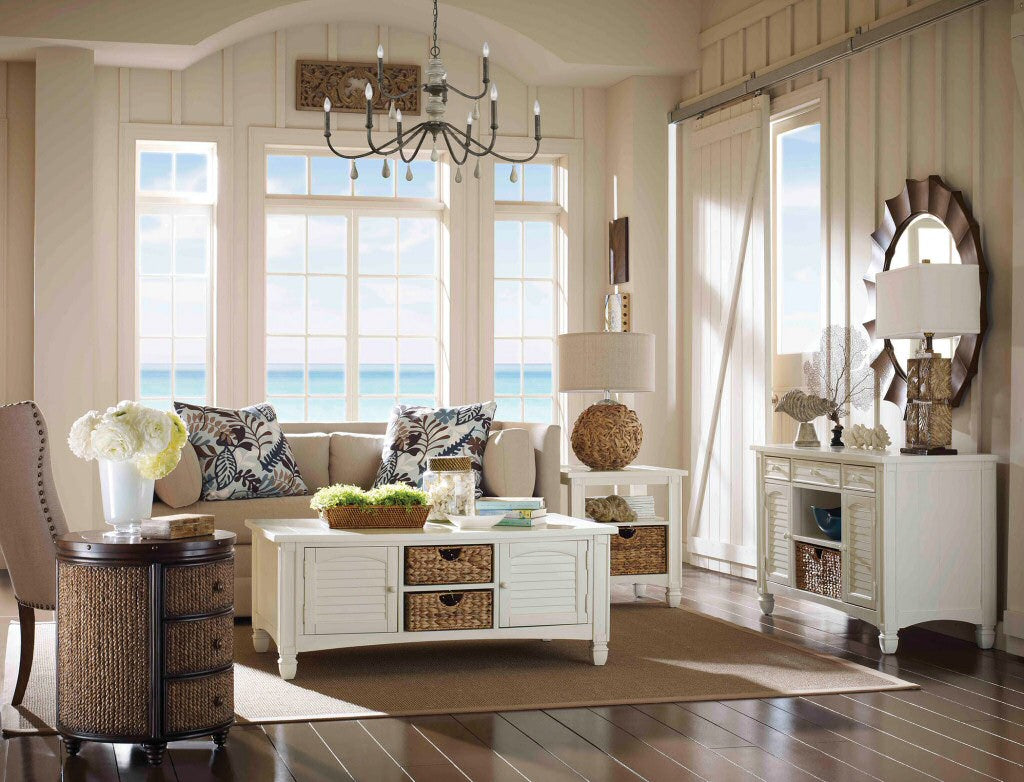
NOW you're ready to start browsing for living room light fixtures and lamps!
Now that you've learned how to choose lighting for living rooms and the different functions of each type of lighting, and the kind of light they output in different parts of the room, you can now start to explore the vast array of options available for your living room.
It's time to start making an informed decision.
We've simplified the options available and categorized them into each of the top 20 types of light fixtures and lamps for living rooms.
We've also arranged these lights in order of best-selling first so that you can see what's popular and which kinds of lights other people are in love with!
Click on a type of light below to discover your new living room lighting:
Ambient lighting
Task lighting
Accent lighting
Feedback and Questions about Living Room Interior Design?
What did you think of this guide? Was there anything missing that you need to know? Let us know in the comments below!
Also feel free to email your questions to our lighting experts at sales@lampsusa.com



























































